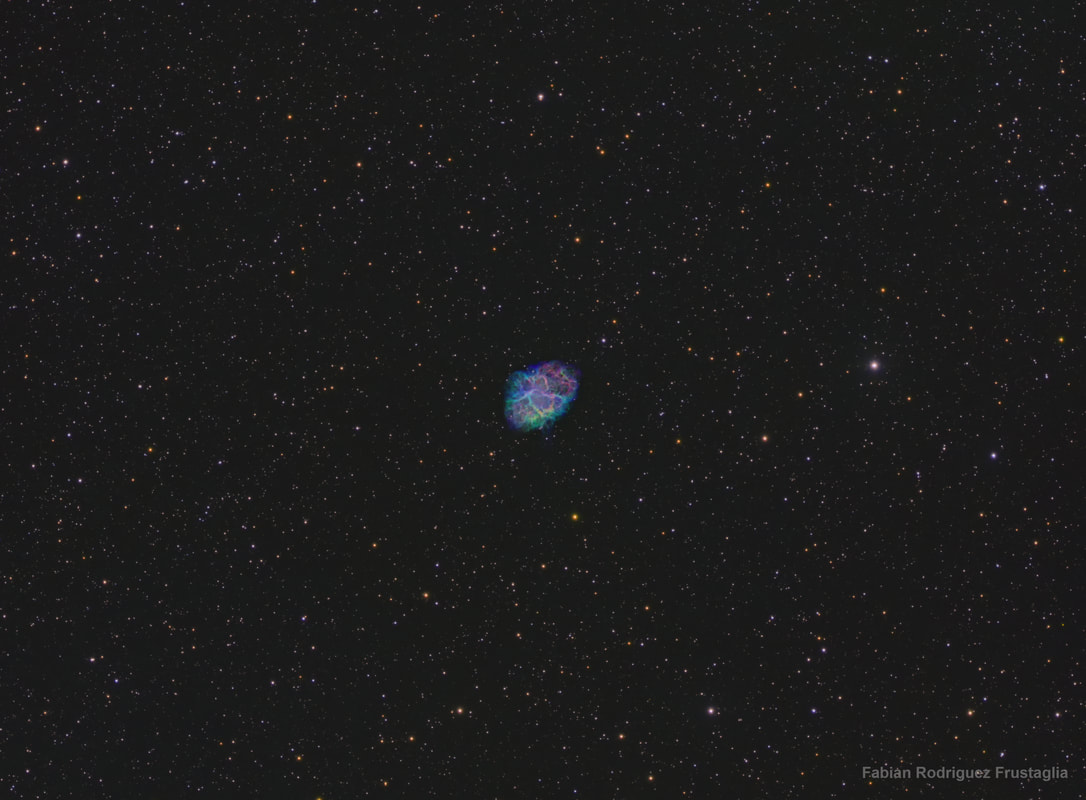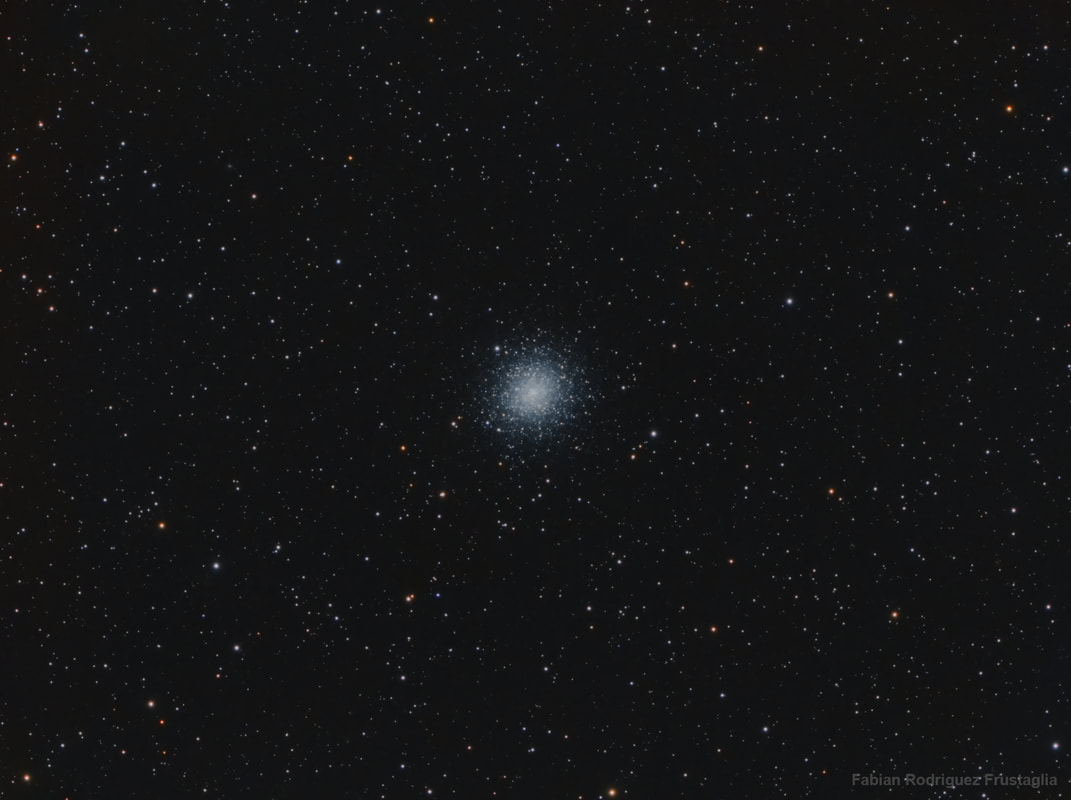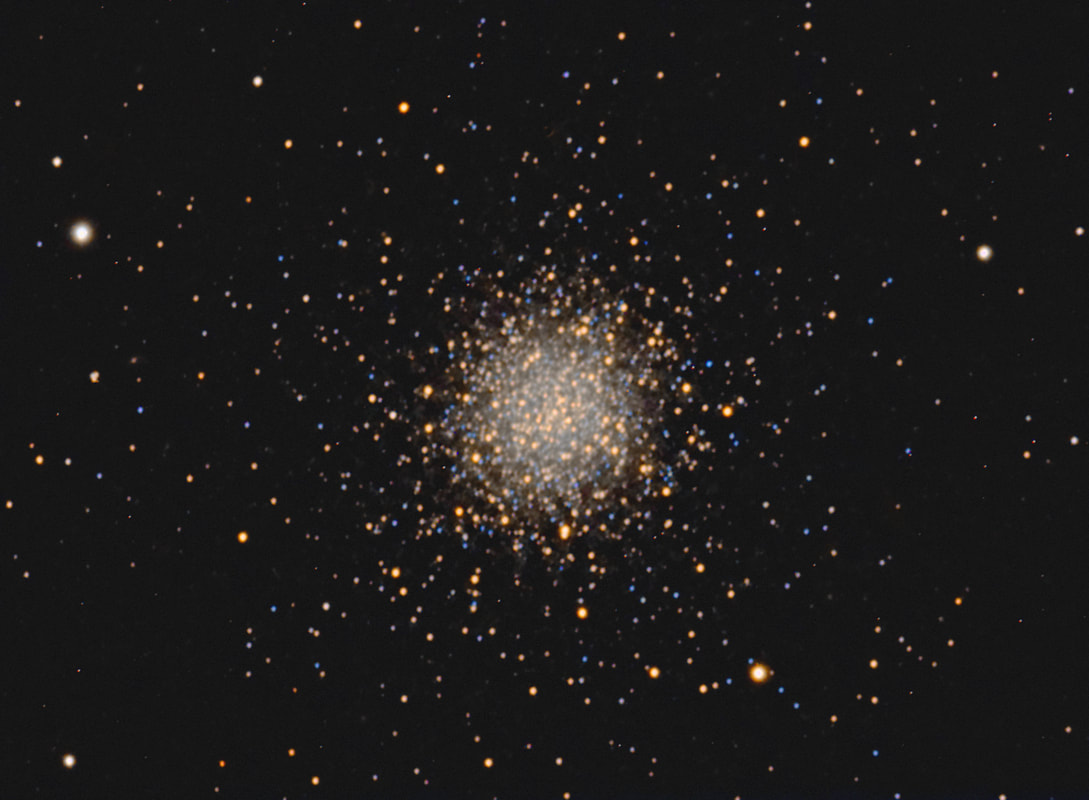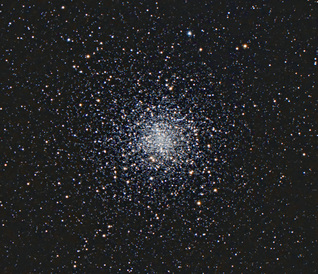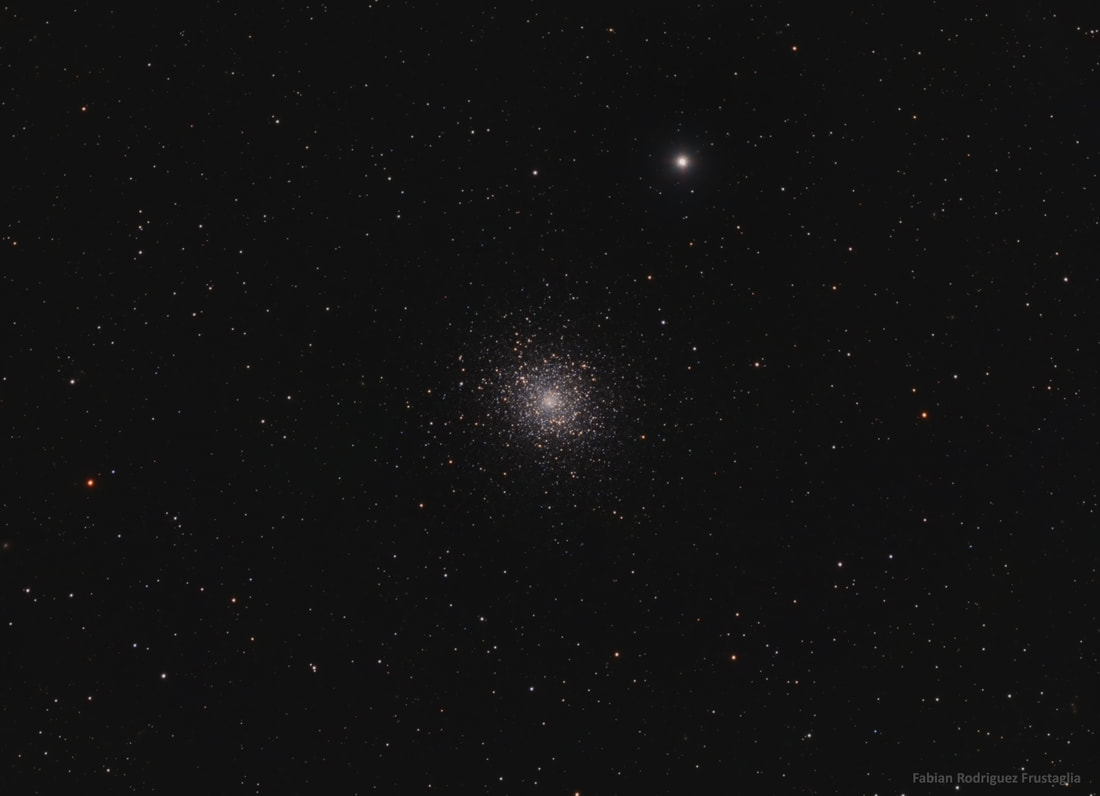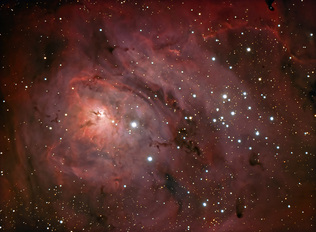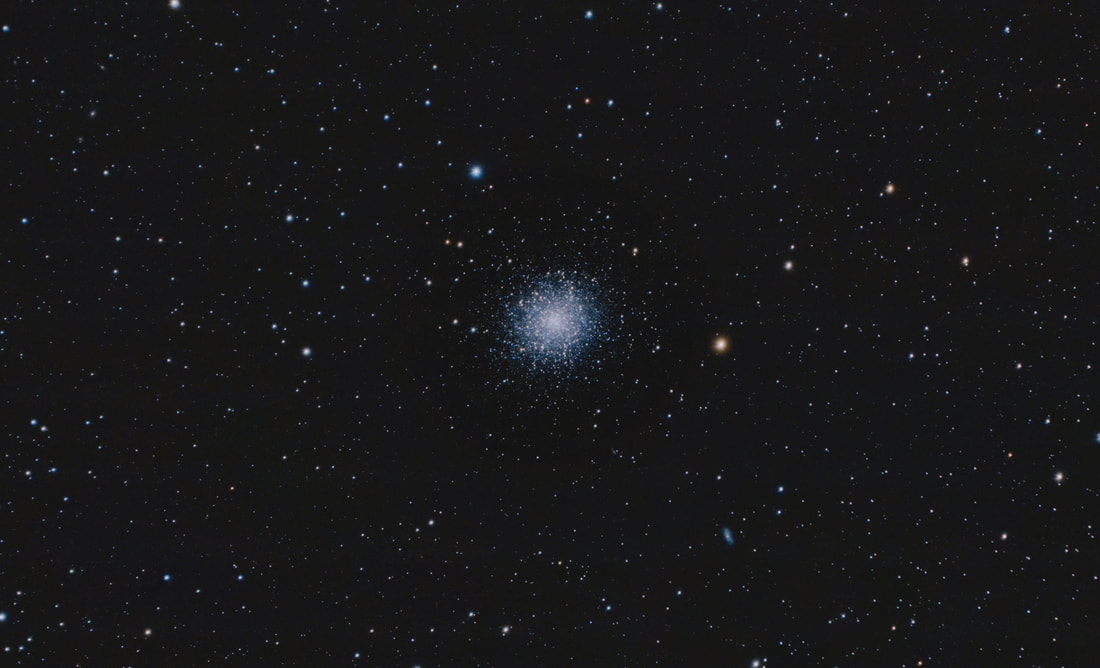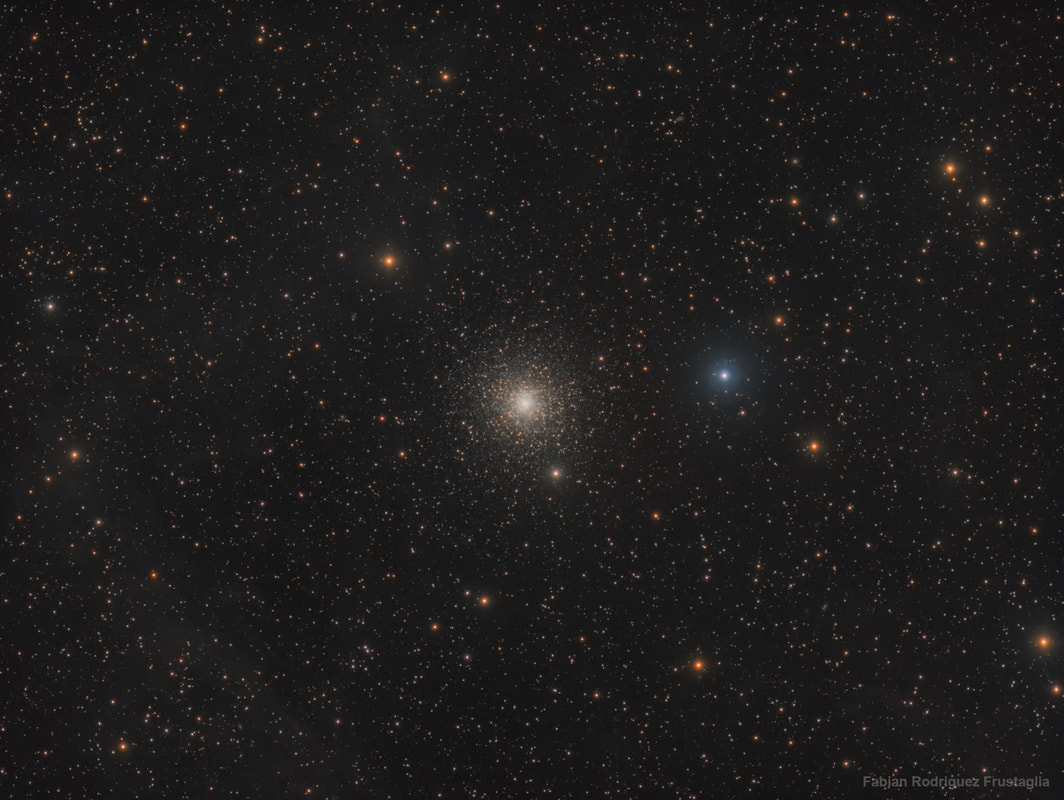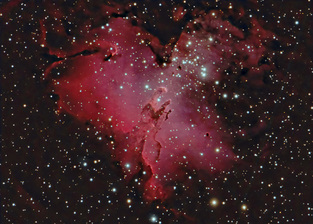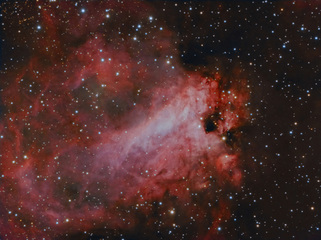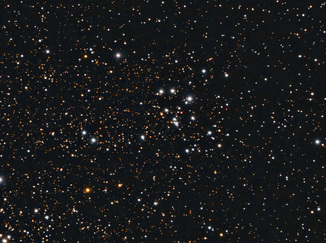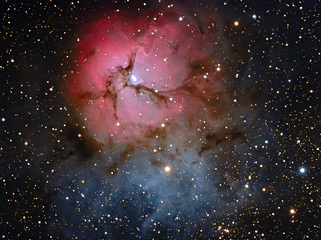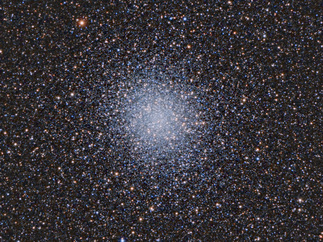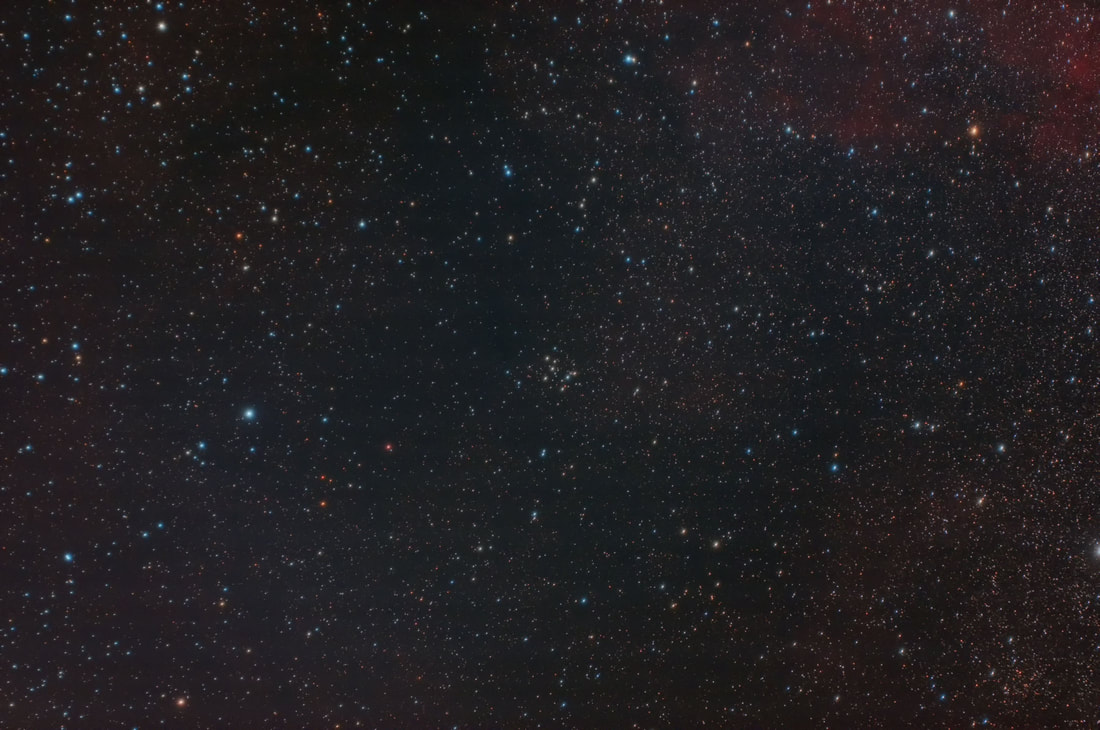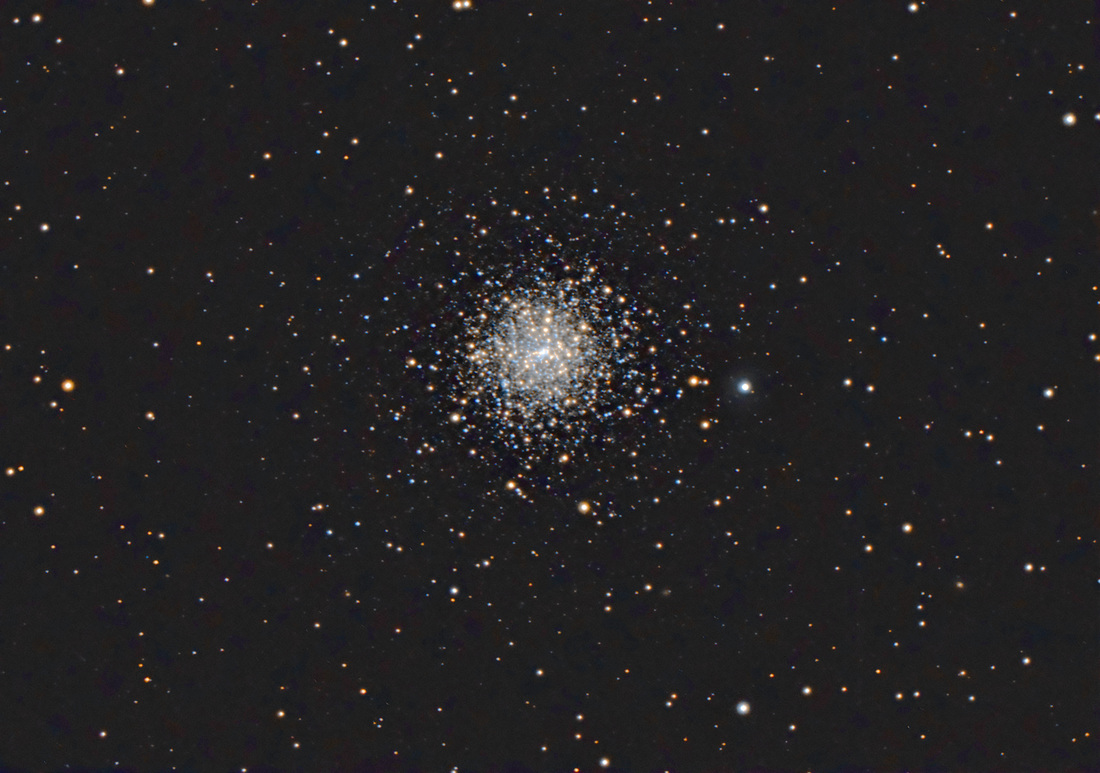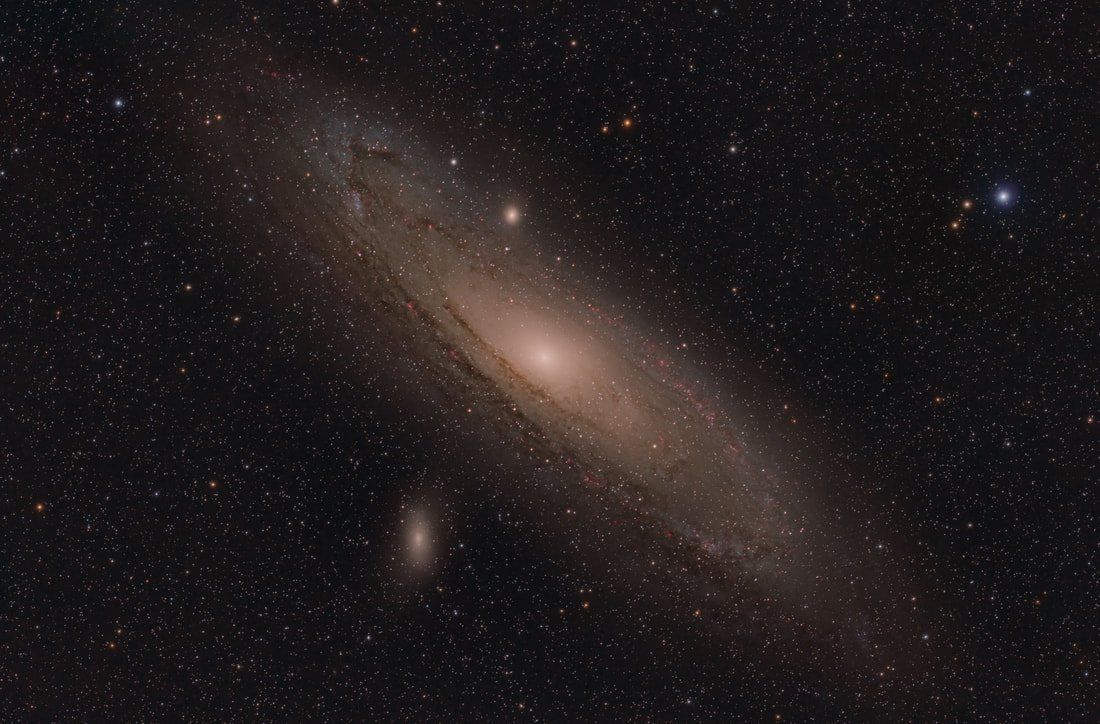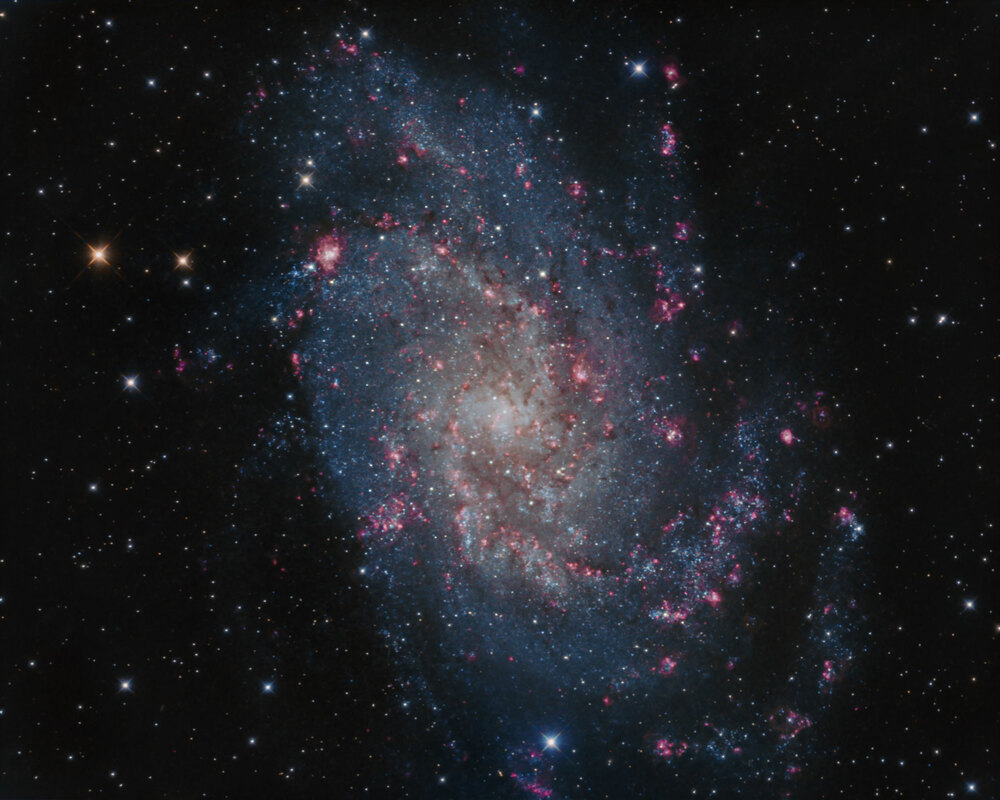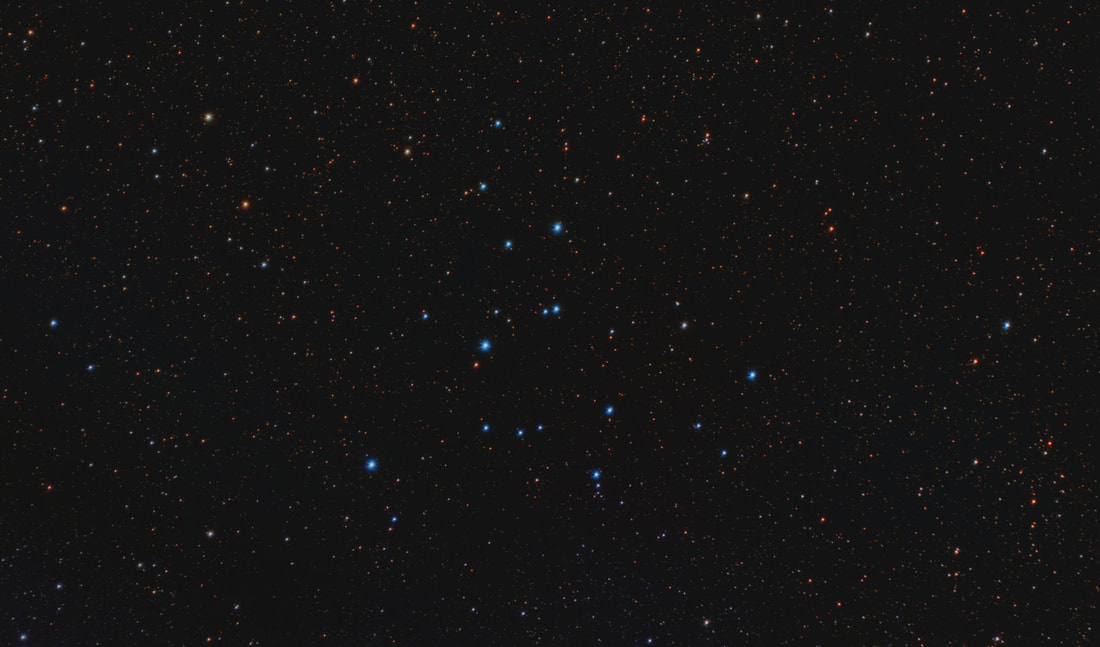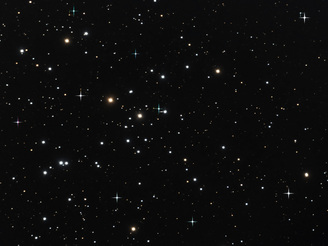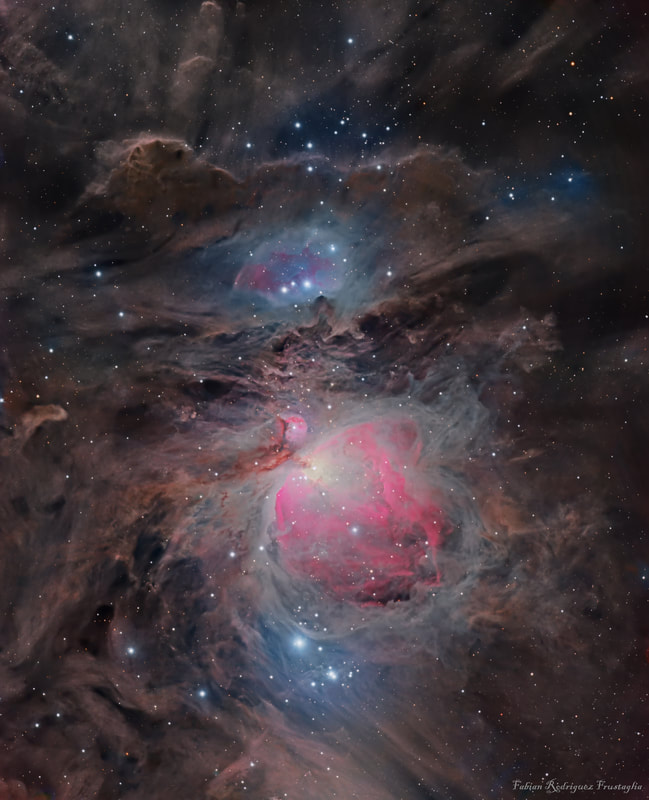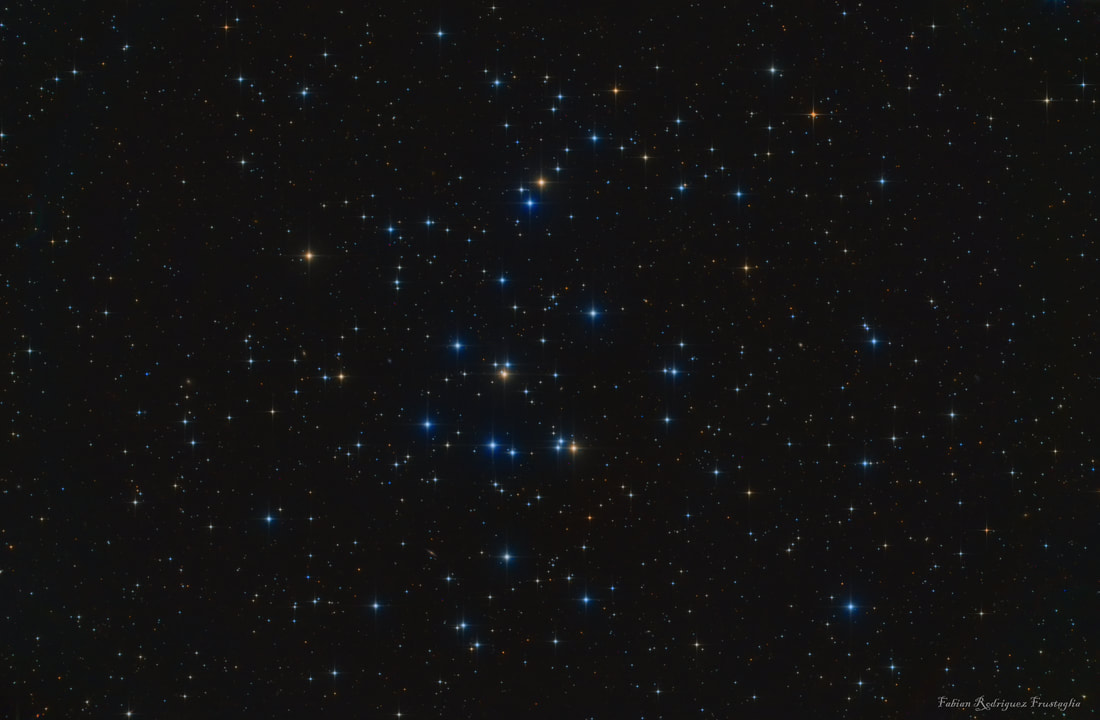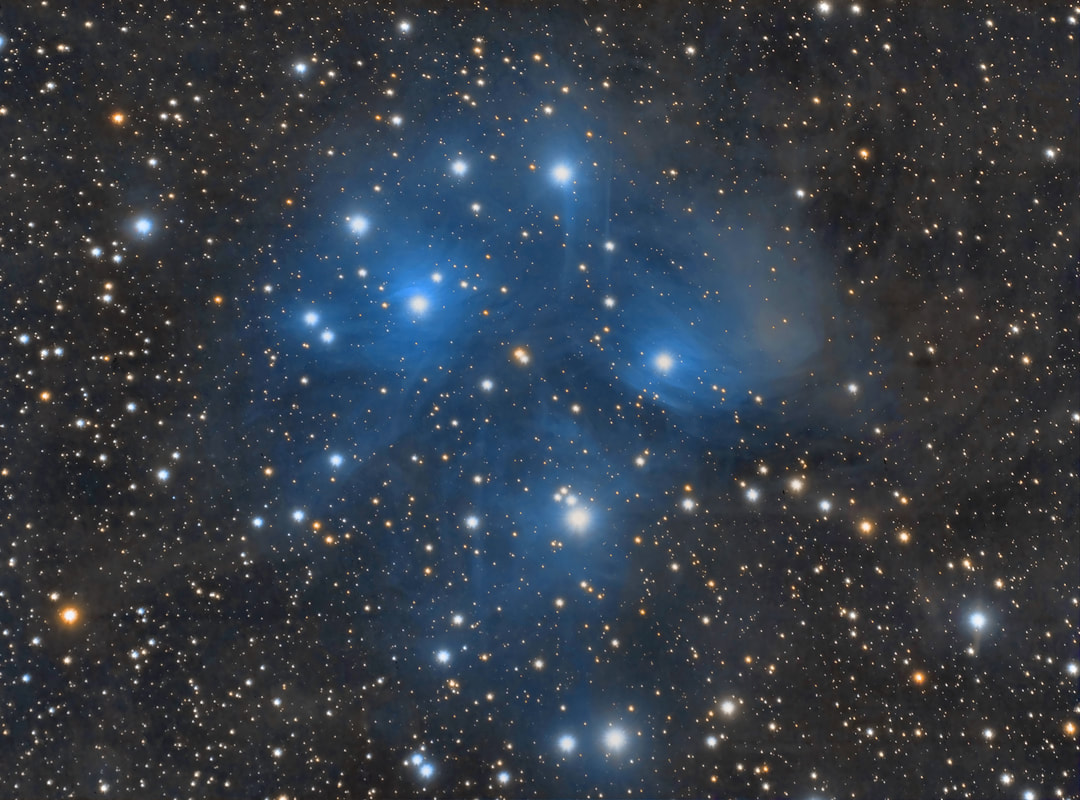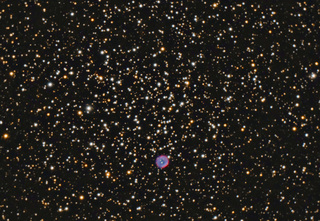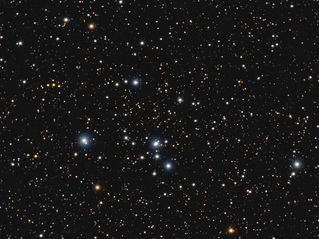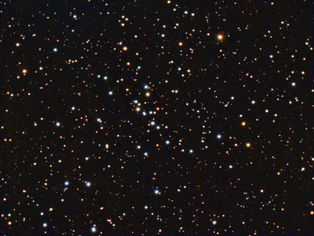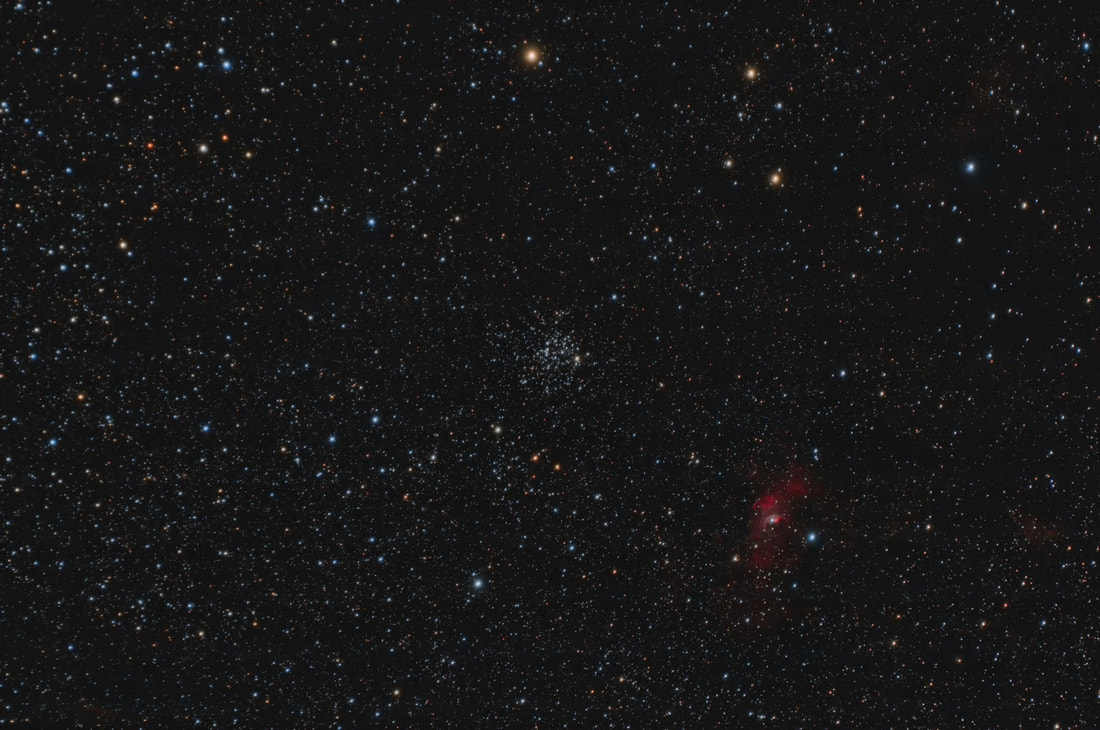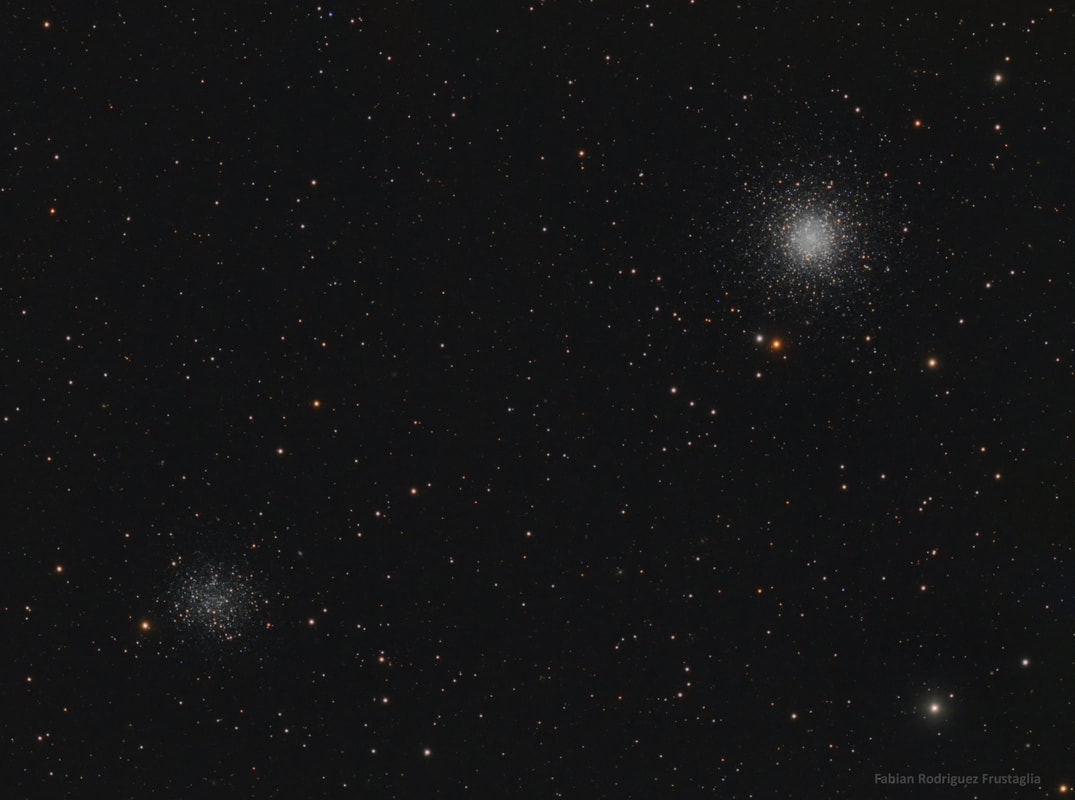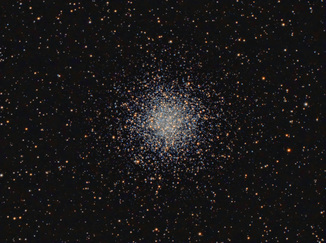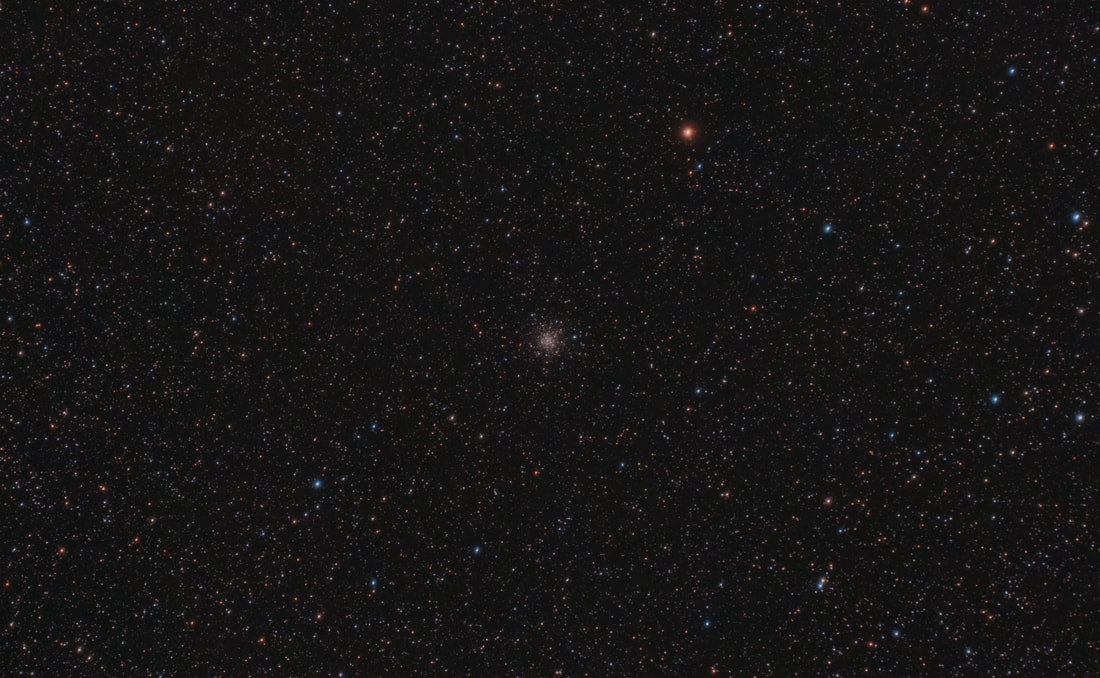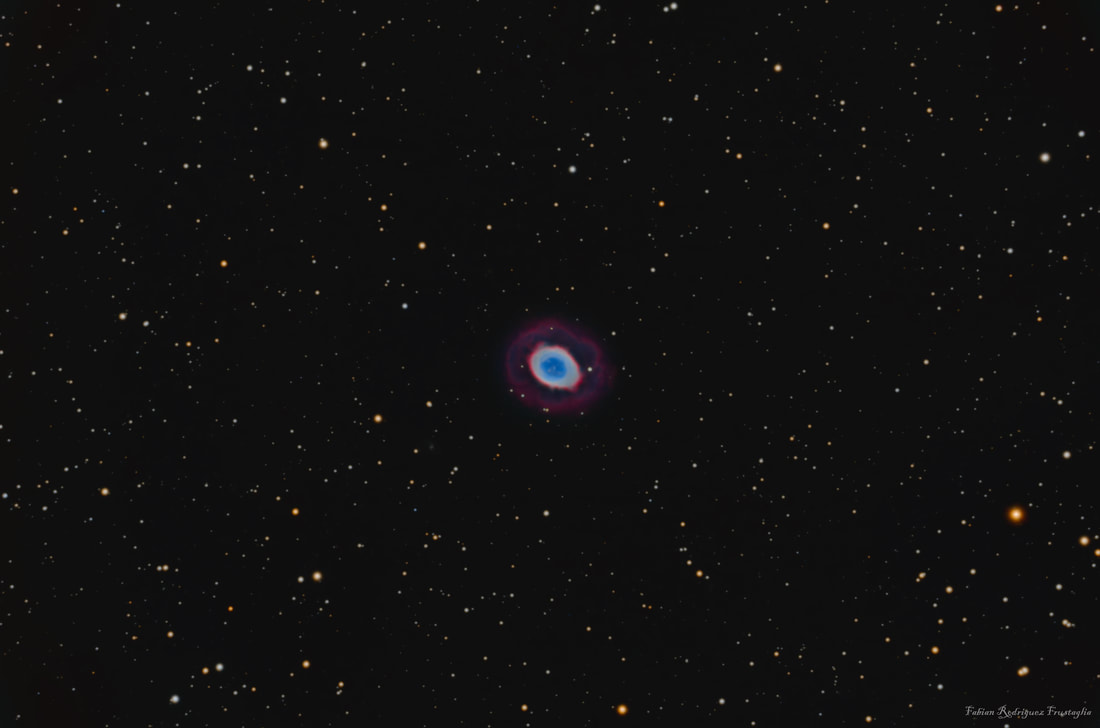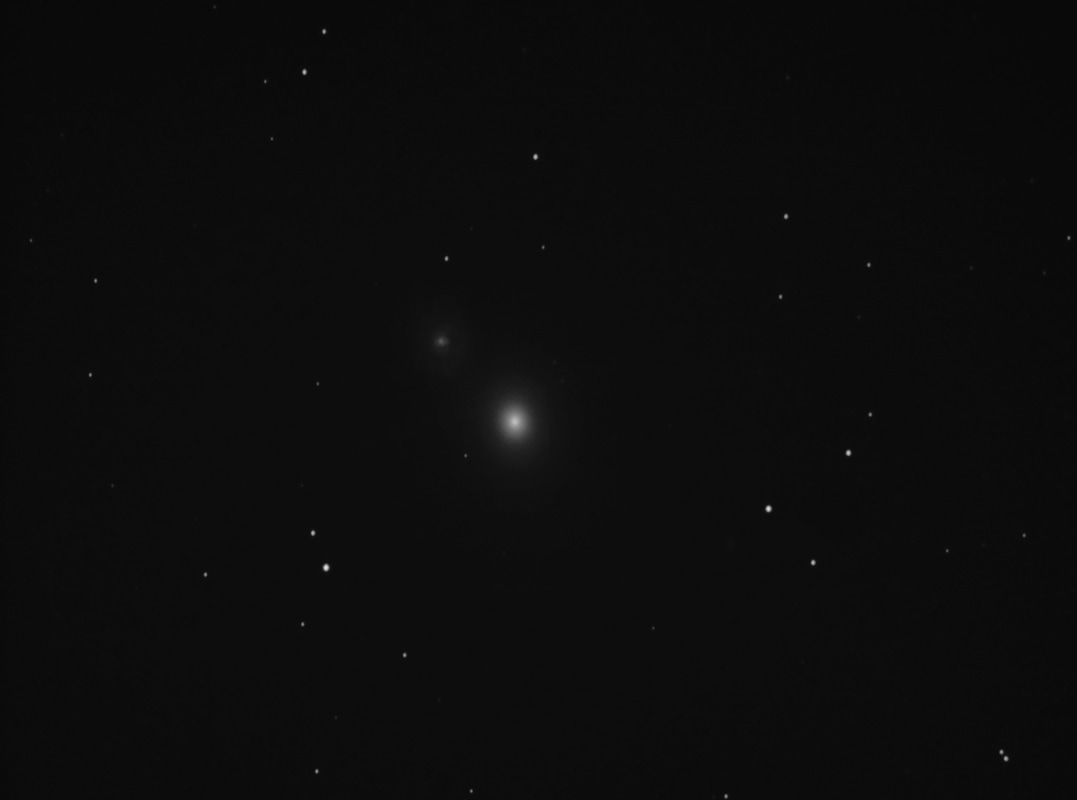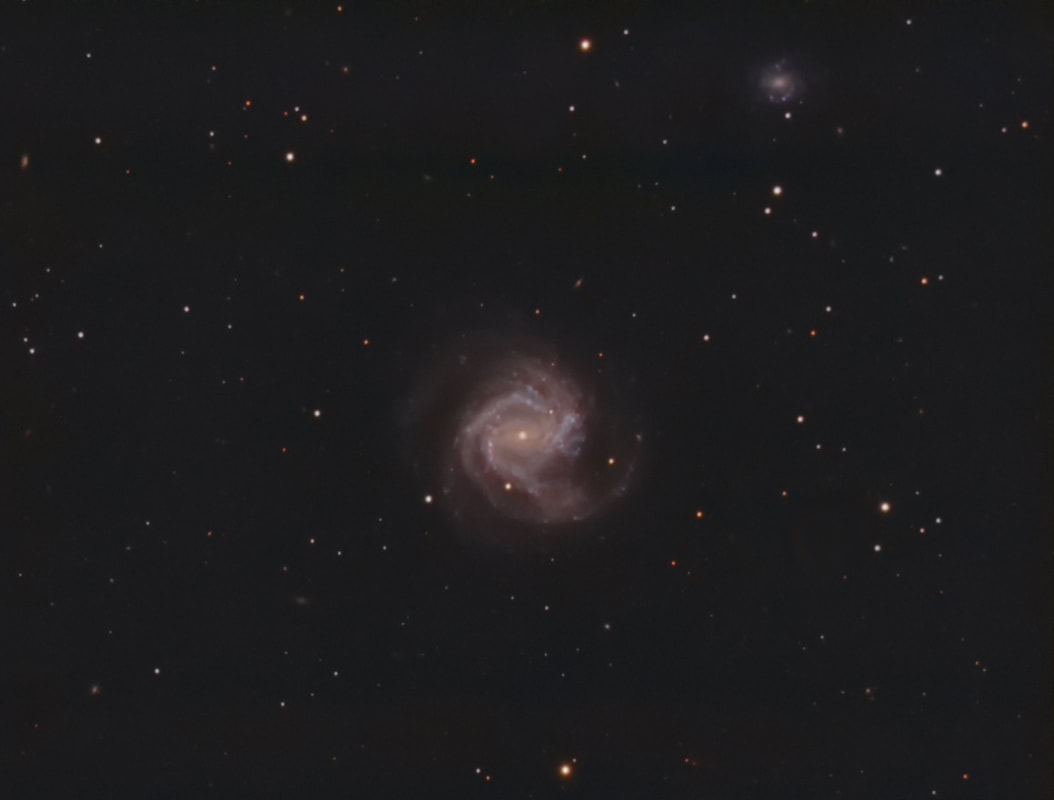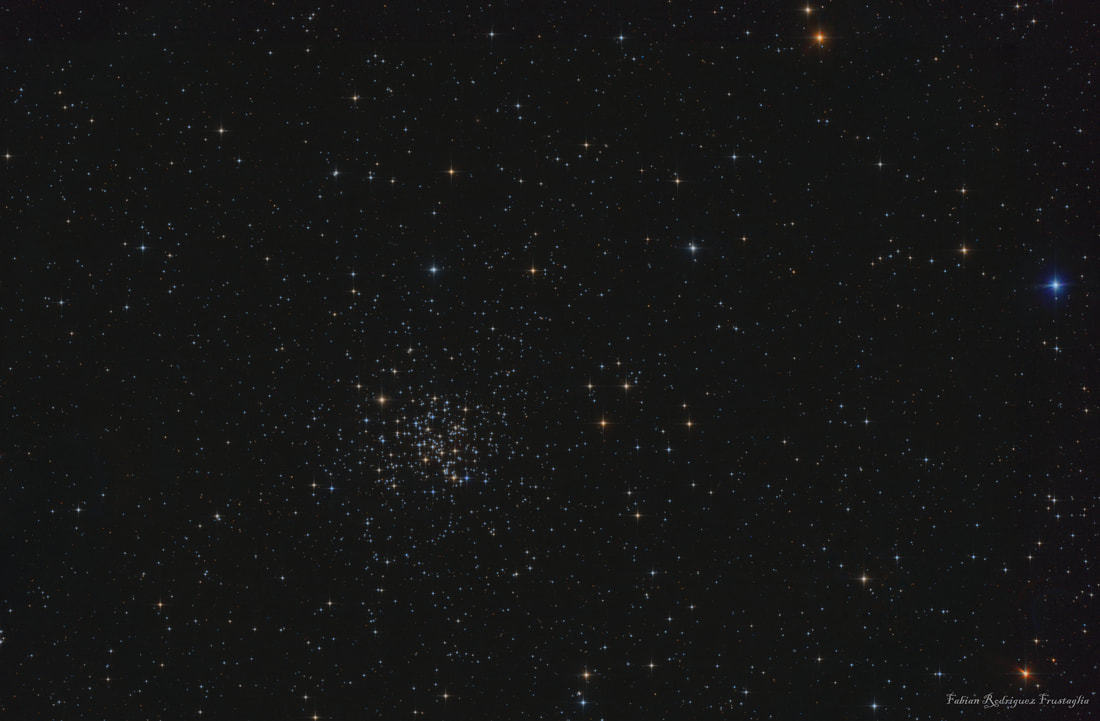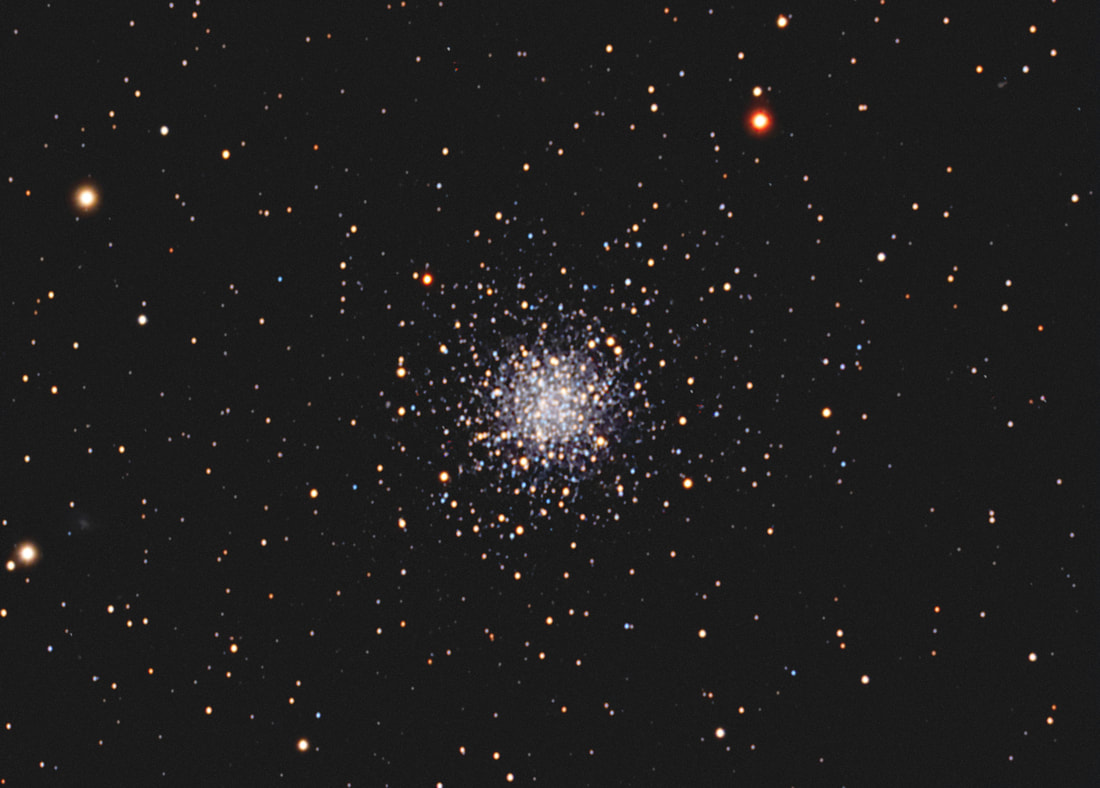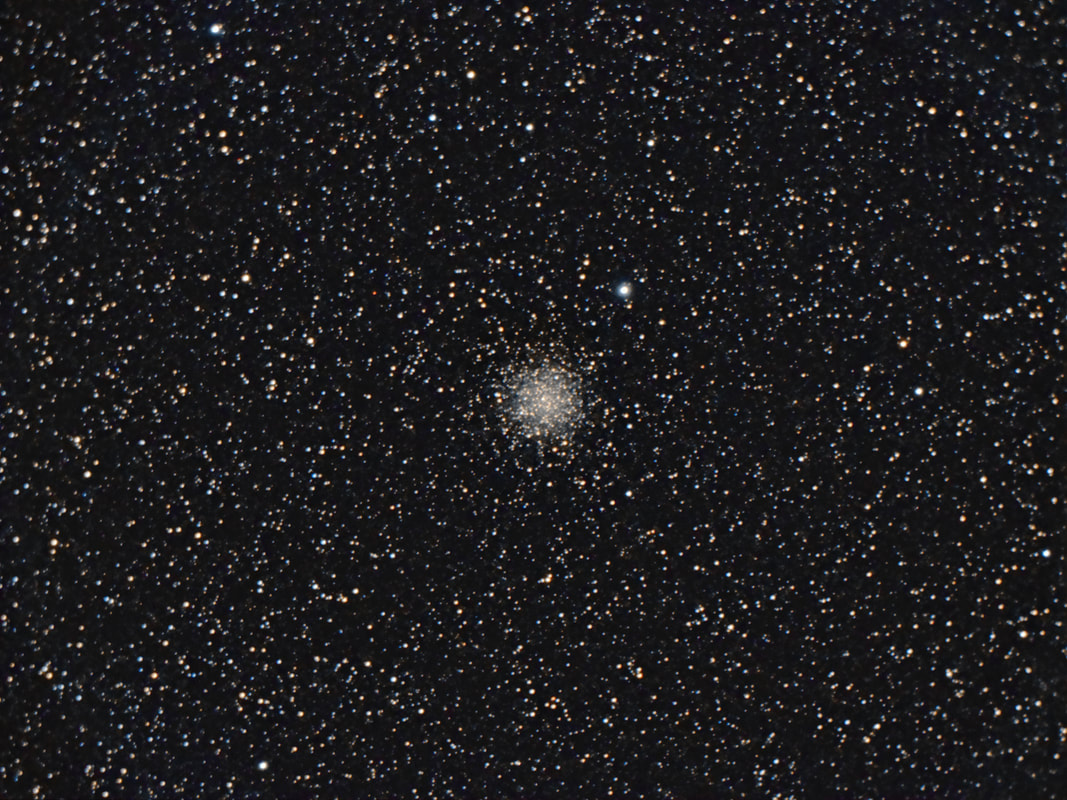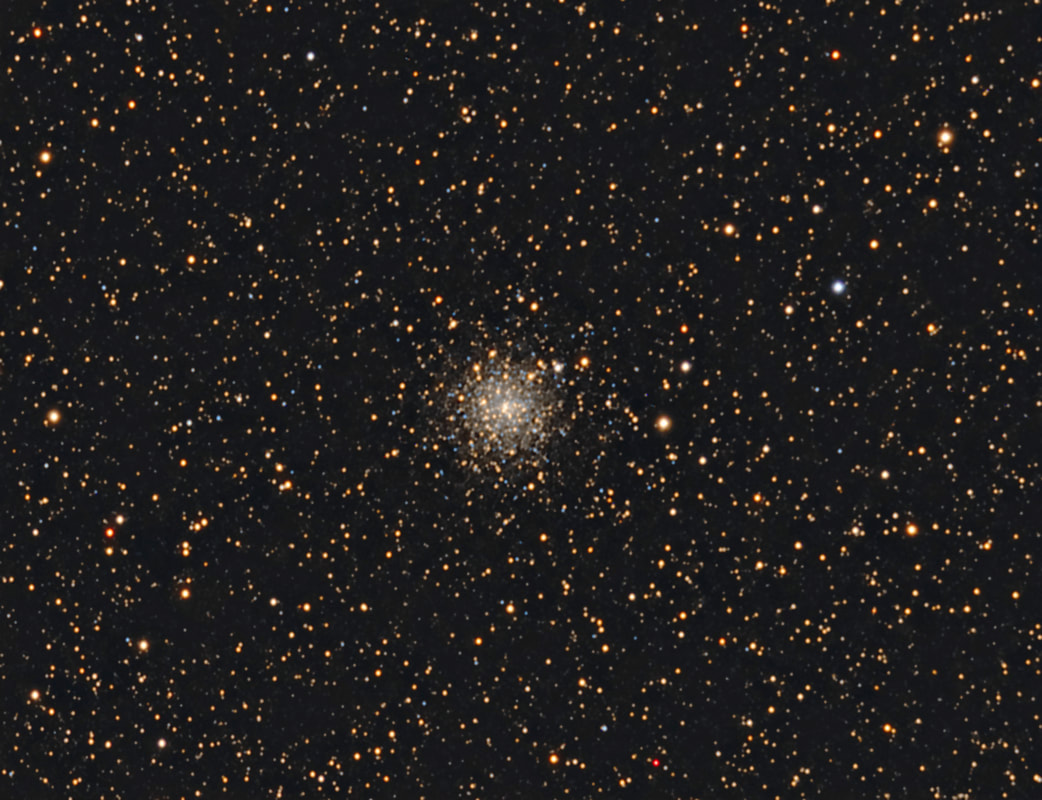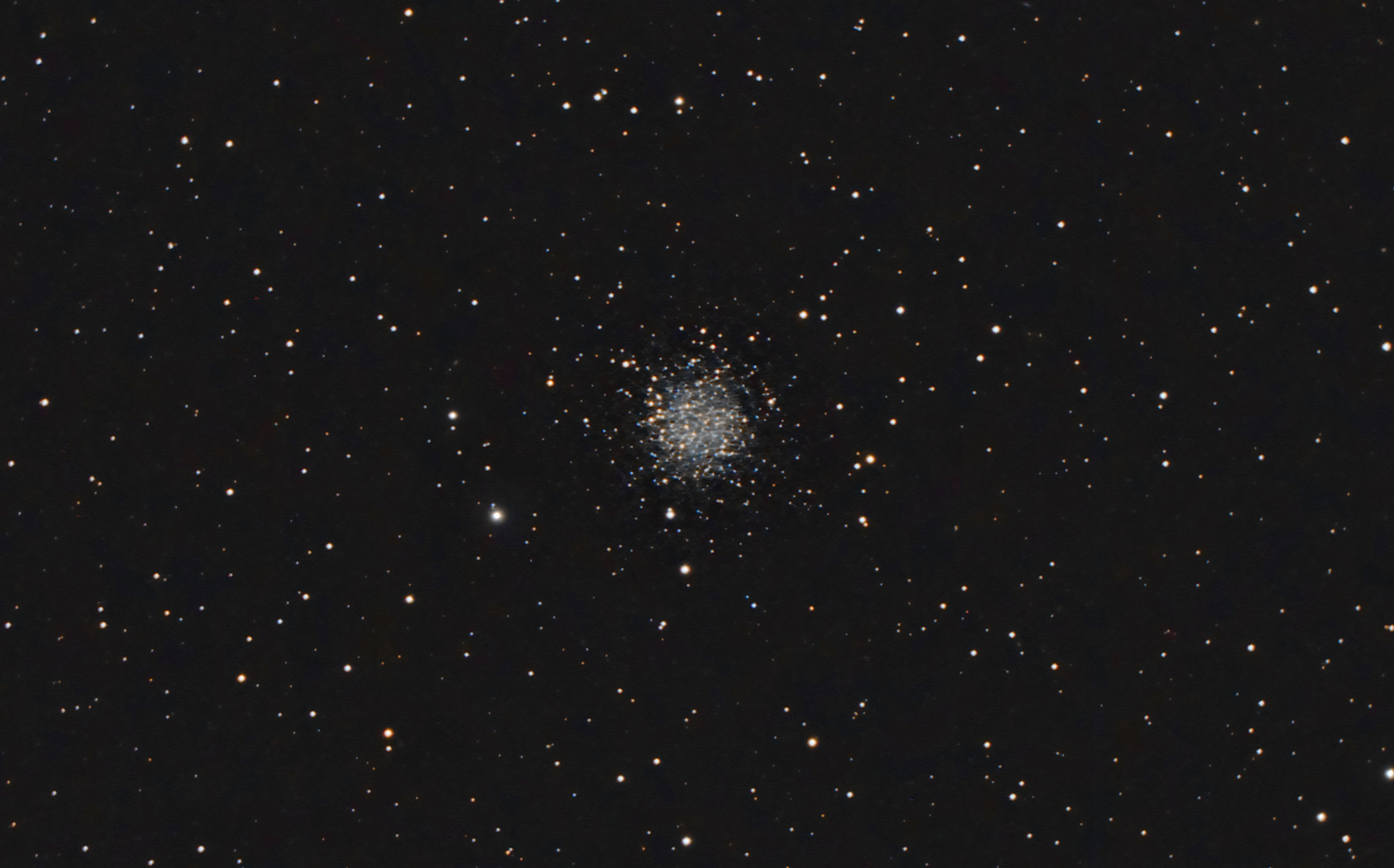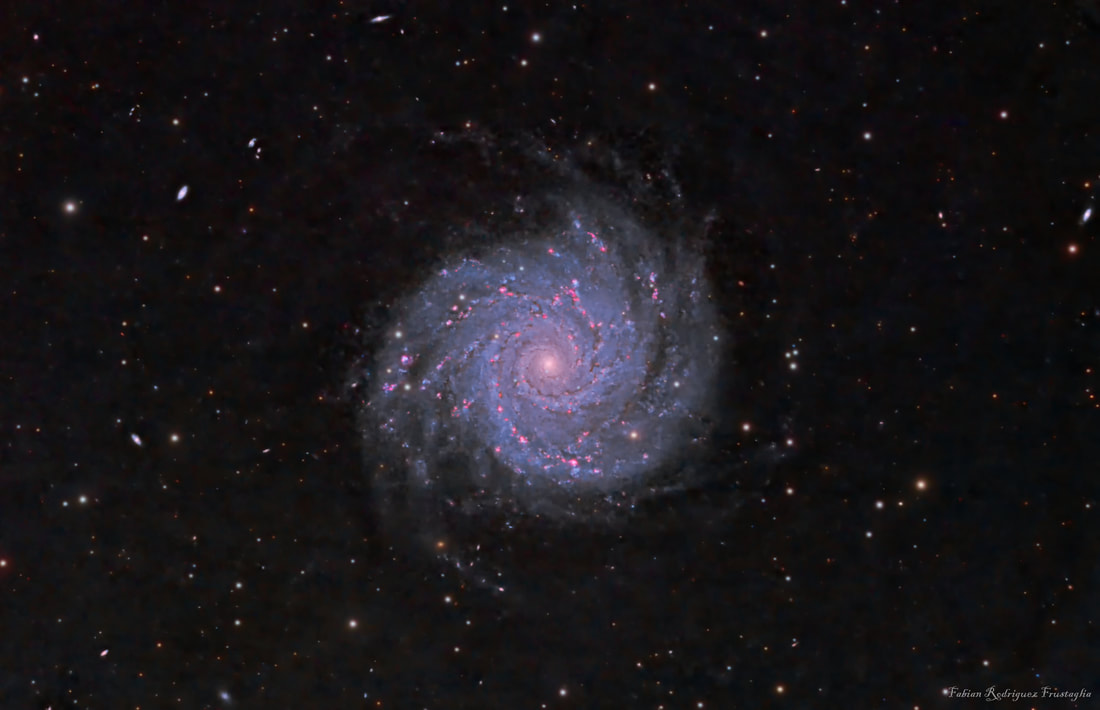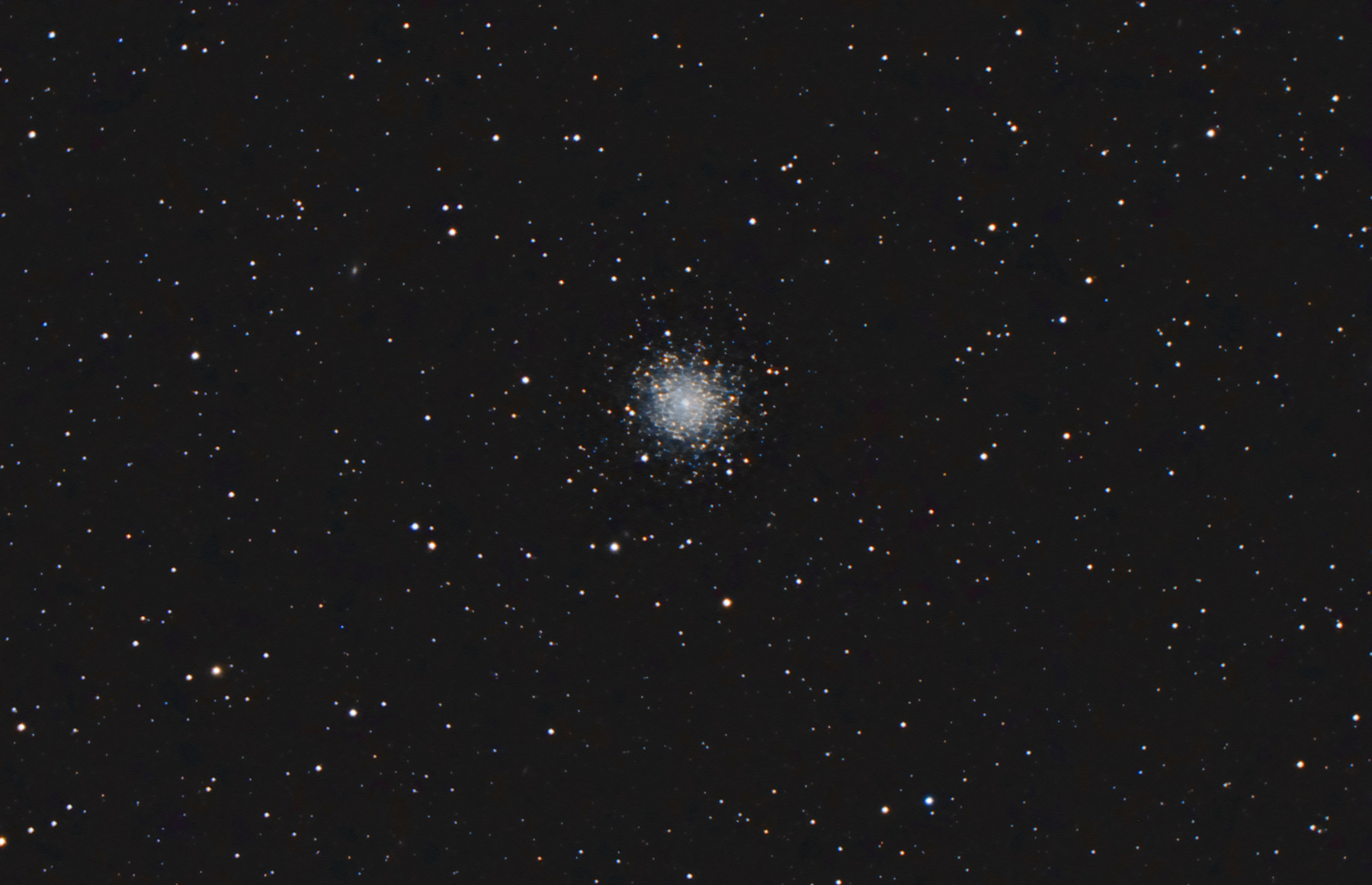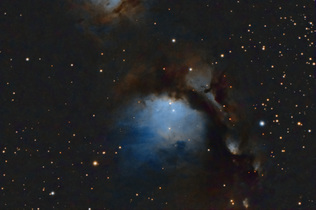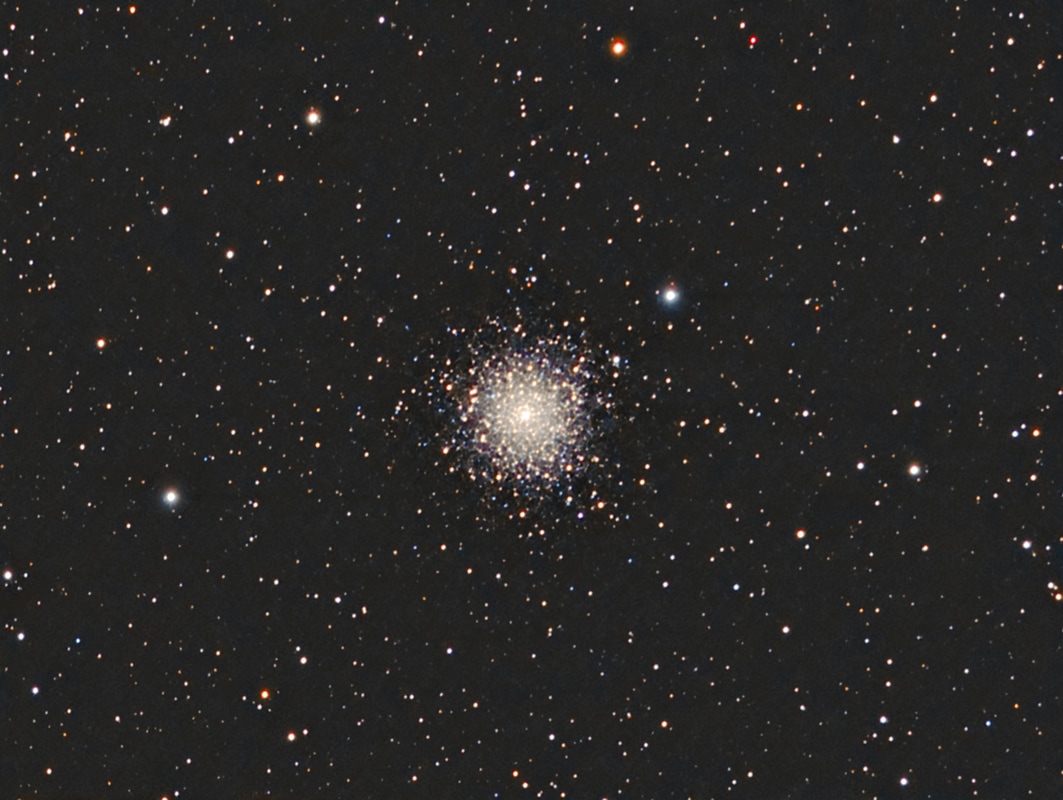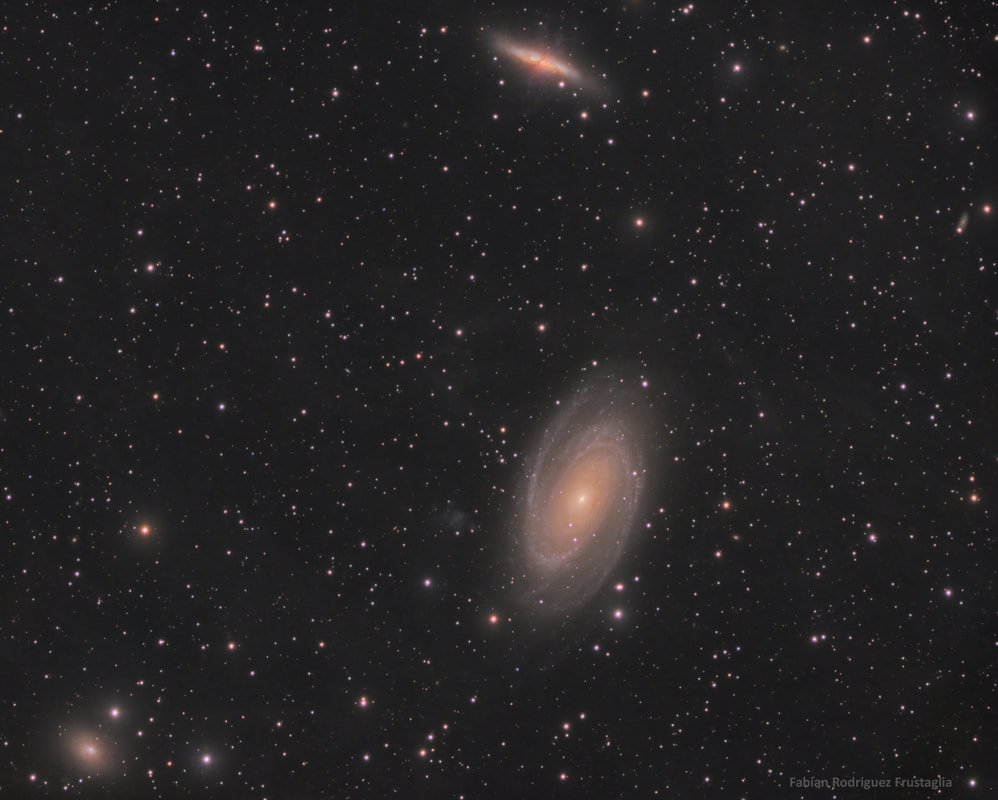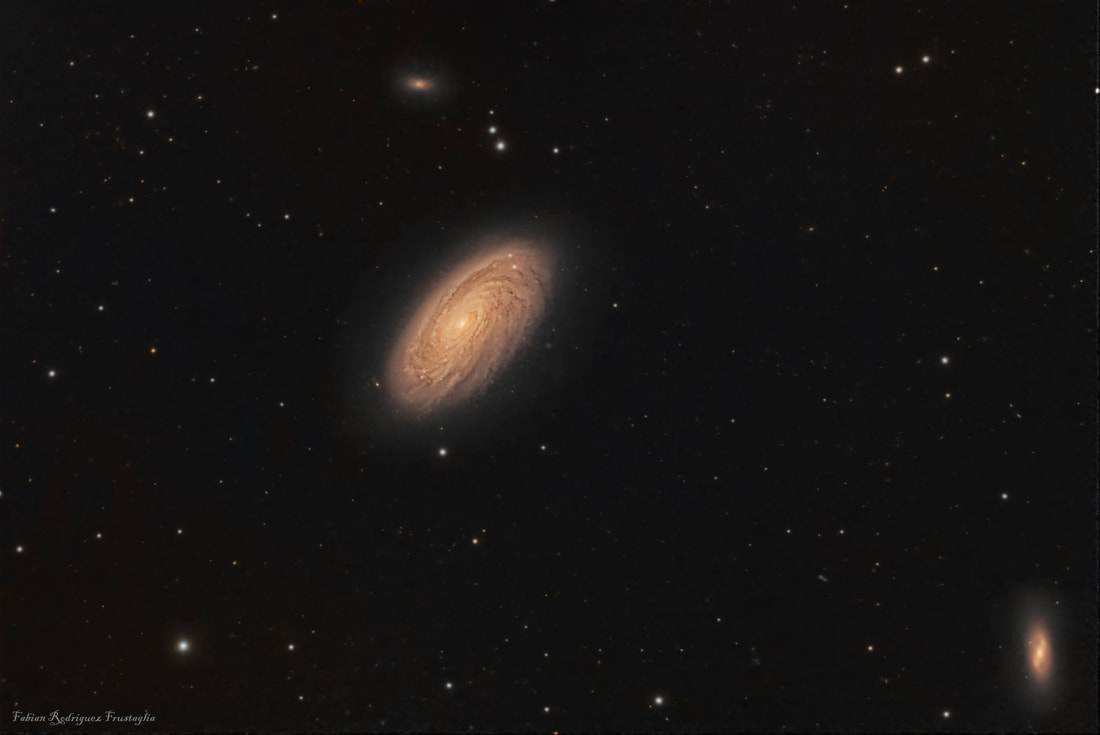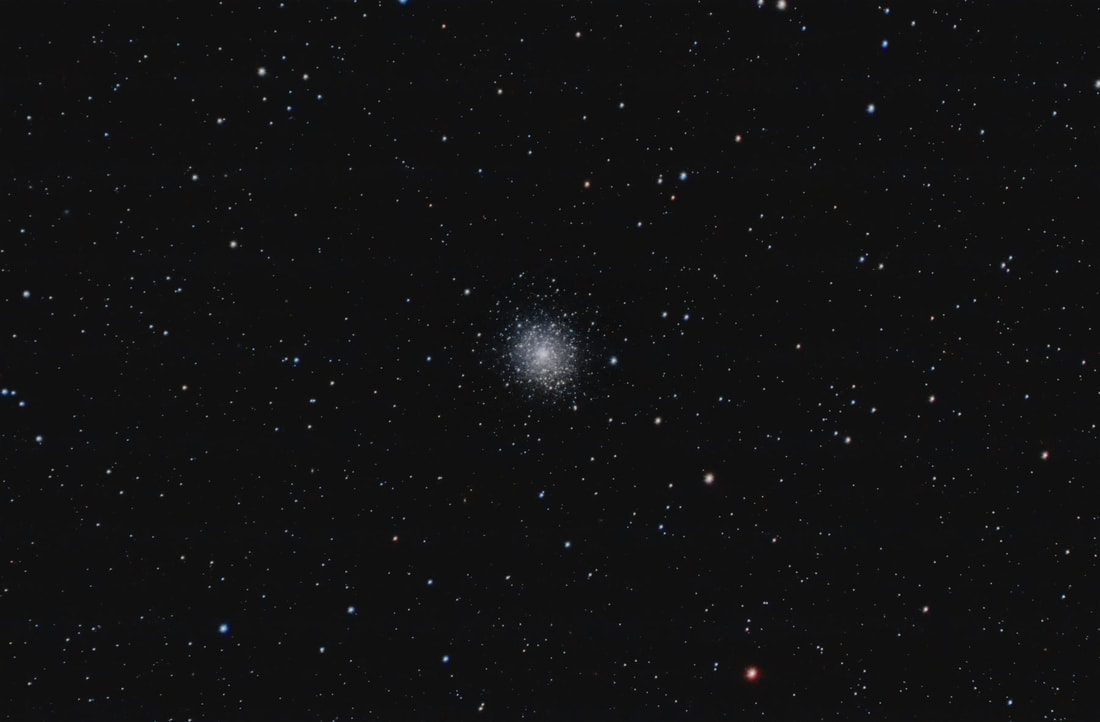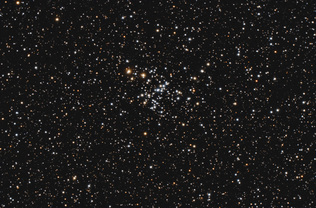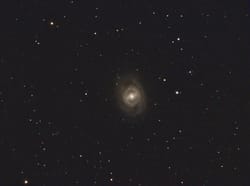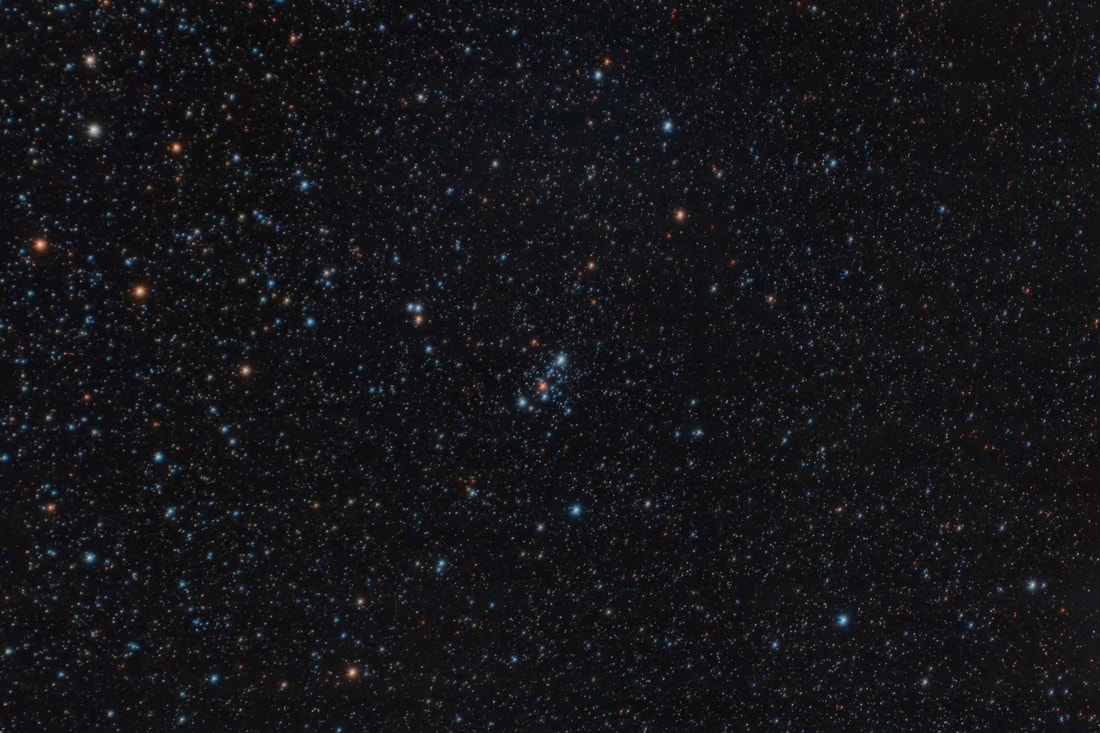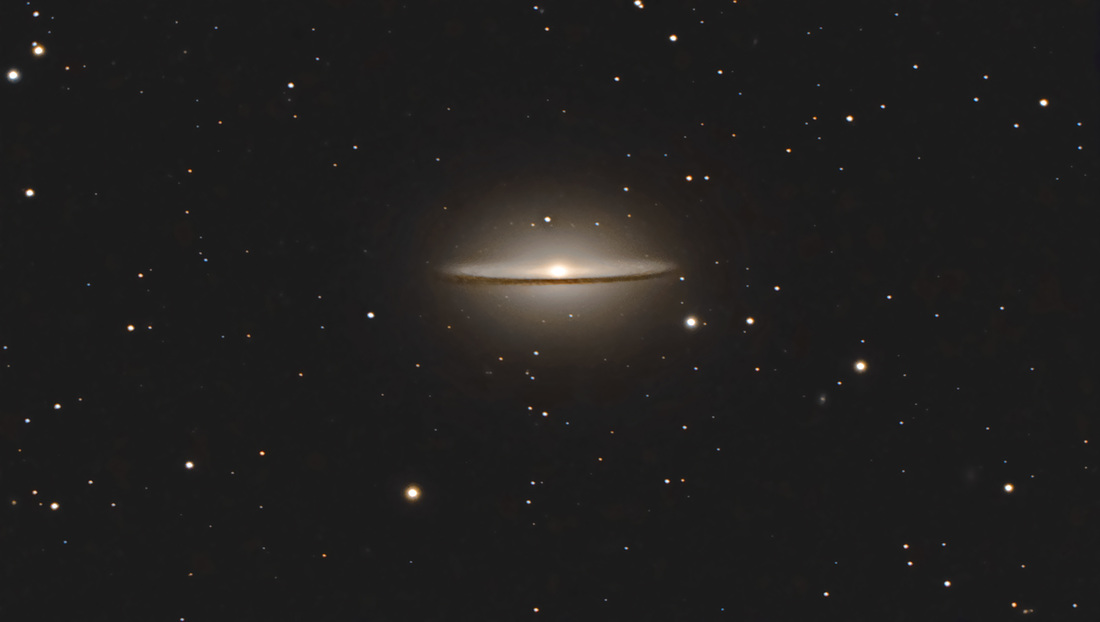Messier Objects
CLICK ON AN IMAGE TO VIEW IT AT FULL RESOLUTION
|
Messier 1 (Crab Nebula)
The Crab Nebula (catalogue designations M1, NGC 1952, Taurus A) is a supernova remnant and pulsar wind nebula in the constellation of Taurus. The common name comes from William Parsons, who observed the object in 1840 using a 36-inch telescope and produced a drawing that looked somewhat like a crab. The nebula was discovered by English astronomer John Bevis in 1731, and it corresponds with a bright supernova recorded by Chinese astronomers in 1054. The nebula was the first astronomical object identified that corresponds with a historical supernova explosion. Telescope: Meade Series 6000 115mm f/5.6 Camera: ZWO ASI 1600 Filters: Ha, OIII, SII Astrodon filters. Date: November 2020 Exposure: 36 x 600" = 6.0 hrs |
|
Messier 2
Messier 2 or M2 (also designated NGC 7089) is a globular cluster in the constellation Aquarius, five degrees north of the star Beta Aquarii. It was discovered by Jean-Dominique Maraldi in 1746, and is one of the largest known globular clusters. Telescope: Meade Series 6000 115mm f/5.6 Camera: ZWO ASI 1600 Filters: ZWO Date: September 2020 Exposure: 52 x 300" = 4.3 hrs |
|
Messier 3
Messier 3 (M3 or NGC 5272) is a globular cluster of stars in the northern constellation of Canes Venatici. It was discovered by Charles Messier on May 3, 1764. M3 has an apparent magnitude of 6.2, making it a difficult naked eye target even with dark conditions. Messier 3 is located 31.6 kly above the Galactic plane and roughly 38.8 kly from the center of the Milky Way. It contains 274 known variable stars; by far the highest number found in any globular cluster. Telescope: Meade LX850 12" f/8 Camera: QHY9 LRGB filters Date: June 2017 Exposure: RGB: 11x5' = 0.9 hrs |
|
Messier 4
Messier 4 or M4 (also designated NGC 6121) is a globular cluster in the constellation of Scorpius. It was discovered by Philippe Loys de Chéseaux in 1746 and catalogued by Charles Messier in 1764. It was the first globular cluster in which individual stars were resolved. It is one of the easiest globular clusters to be found, being located only 1.3 degrees west of the bright star Antares. The cluster is located at only 7,200 ly from our solar system, being the closest Gb to Earth. Telescope: Meade LX850 12" f/5.7 (telecompressor Lepus 0.62X) Camera: SBIG STF-8300C Date: Septembre 2016 Exposure: 19 x 5' = 1.6 hrs |
|
Messier 5
Messier 5 or M5 (also designated NGC 5904) is a globular cluster in the constellation Serpens. It was discovered by Gottfried Kirch in 1702. 105 stars in M5 are known to be variable in brightness, 97 of them belonging to the RR Lyrae type. Telescope: Meade Series 6000 115mm f/5.6 Camera: ZWO ASI 1600 Filters: ZWO RGB Date: January 2021 Exposure: 36 x 300" = 3.0 hrs |
|
Messier 8 - Lagoon Nebula
The Lagoon Nebula (M8 or NGC 6523) is a giant interstellar cloud in the constellation Sagittarius, it is clasified as an emission nebula and HII region. It is a star forming nebula that can be seen with the naked eye, open cluster NGC 6530 lies in the foreground. The object contains several Bok globules (dark collapsing clouds of protostar material). At magnitud 6.0, lies at 4,100 light-years from our Solar System. Telescope: Meade LX850 12" f/8 Camera: SBIG STF-8300C Date: July 2015 Exposure: 18 x 10' = 3.0 hrs |
|
Messier 13
Messier 13 or M13, also designated NGC 6205 and sometimes called the Great Globular Cluster in Hercules or the Hercules Globular Cluster, is a globular cluster of several hundred thousand stars in the constellation of Hercules. M13 was discovered by Edmond Halley in 1714, and cataloged by Charles Messier on June 1, 1764 into his list of objects not to mistake for comets; Messier's list, including Messier 13, eventually became known as the Messier Catalog Telescope: William Optics GTF-81 f/5.9 Camera: QHY168C Filters: Optolong L-Pro Date: September 2019 Exposure: 32x5' = 2.7 hrs |
|
Messier 15
Messier 15 or M15 (also designated NGC 7078) is a globular cluster in the constellation Pegasus. It was discovered by Jean-Dominique Maraldi in 1746 and included in Charles Messier's catalogue of comet-like objects in 1764. At an estimated 12.0 billion years old, it is one of the oldest known globular clusters. Telescope: Meade Series 6000 115mm f/5.6 Camera: ZWO ASI 1600 Filters: ZWO Date: September 2020 Exposure: 55 x 300" = 4.6 hrs |
|
Messier 16 - Eagle Nebula
The Eagle Nebula (M16 or NGC 6611) is a young open cluster of star in the constellation Serpens, it was discovered by Jean-Philippe Cheseaux in 1745. Its name derives from its shape that is thought to resemble an eagle. It contains several active star forming, gas and dust regions, including the famous "Pillars of Creation", photographed by the Hubble Space Telescope. At magnitud 6.0, lies 7,000 light-years from Earth. Telescope: Meade LX850 12" f/8 Camera: SBIG STF-8300C Date: August 2015 Exposure: 23 x 10' = 3.8 hrs |
|
Messier 17 - Omega Nebula
The Omega Nebula also known as Swan Nebula, is an HII region in the constellation Sagittarius. It was discovered by Philippe Cheseaux in 1745 and Chales Messier catalogued it in 1764. It is located in the rich starfields of the Sagittarius area of the Milky Way. It is considered one of the brightest and most massive star-forming regions of our galaxy. Its local geometry is similar to the Orion Nebula except that it is viewed edge-on rather than face-on. The open cluster NGC 6618 lies embedded in the nebulosity and causes the gases of the nebula to shine due to radiation from these hot young stars. At magnitud 6.0, lies 6,000 light-years from Earth. Telescope: Meade LX850 12" f/8 Camera: SBIG STF-8300C Date: August 2015 Exposure: 18 x 10' = 3.0 hrs |
|
Messier 18
M18 (also designated NGC 6613) is an open cluster of stars in the constellation Sagittarius. It was discovered by Charles Messier in 1764 and included in his list of comet-like objects. From the perspective of Earth, M18 is situated between the Omega Nebula (M17) and the Sagittarius Star Cloud (M24). Its age is estimated at 32 million years. It is 4,900 light-years away. Telescope: Meade LX850 12" f/8 Camera: SBIG STF-8300C Date: September 2015 Exposure: 22 x 5' = 1.8 hrs |
|
Messier 20 - Trifid Nebula
THIS IMAGE IS BEING USED BY "MEADE" TO ADVERTISE THE LX850 TELESCOPE IN Sky & Telescope Magazine !!!!!!!!!!!!!!!! The Trifid Nebula (M20 or NGC 6514) is an HII region located in Sagittarius, it was discovered by Charles Messier in 1764. Its name means "divided into three lobes". The object is an unusual combination of an open cluster of stars, an emision nebula (red portion), a reflection nebula (blue portion) and a dark nebula (the 'gaps' in the red portion). At magnitud 6.3, lies 5,200 light-years from Earth. Telescope: Meade LX850 12" f/8 Camera: SBIG STF-8300C Date: July 2015 Exposure: 24 x 10' = 4.0 hrs |
|
Messier 22
M22 or NGC 6656 is an elliptical globular cluster in the constellation Sagittarius, near the Galactic bulge region. It is one of the brightest globulars that is visible in the night sky. M22 was one of the first globulars to be discovered, on August 26, 1665 by A. Ihle and it was included in Charles Messier's catalog of comet-like objects on June 5, 1764. M22 is one of the nearer globular clusters to Earth at a distance of about 10,600 light-years away. Telescope: Meade LX850 12" f/8 Camera: SBIG STF-8300C Date: September 2015 Exposure: 30 x 5' = 2.5 hrs |
|
Messier 29
Messier 29, also known as NGC 6913, is an open cluster of star in the Cygnus constellation. It was discovered by Charles Messier in 1764, and can be seen from Earth by using binoculars. The star cluster is situated in the highly crowded area of Milky Way near Gamma Cygni, at a distance of 7,200. Messier 29 can be found quite easily as it is about 1.7 degrees south and a little east of Gamma or 37 Cygni (Sadr). In the vicinity of Messier 29, there is some diffuse nebulosity which can be detected in photographs. Telescope: William Optics GTF-81 f/5.0 Camera: QHY-168C Filter: Optolong L-Pro Date: September 2019 Exposure: 18 x 5' = 1.5 hrs |
|
Messier 30
Messier 30 (also known as M30 or NGC 7099) is a globular cluster of stars in the southern constellation of Capricornus. M30 is located at a distance of about 27,100 light-years from Earth, and is about 93 light-years across. The cluster is following a retrograde orbit through the inner galactic halo, suggesting that it was acquired from a satellite galaxy rather than forming within the Milky Way. It is currently located at a distance of about 26 klyfor the Sun. The M30 cluster has passed through a dynamic process called core collapse and now has a concentration of mass at its core of about a million times the Sun's mass per cubic parsec. This makes it one of the highest density regions in the Milky Way galaxy. Telescope: Meade LX850 12" f/5.7 (telecompressor Lepus 0.62X) Camera: SBIG STF-8300C Date: Octobre 2016 Exposure: 24 x 5' = 2.0 hrs |
|
Messier 31 - Andromeda Galaxy
The Andromeda Galaxy, also known as Messier 31, M31, or NGC 224 and originally the Andromeda Nebula, is a spiral galaxy approximately 2.5 million light-years from Earth, and the nearest major galaxy to the Milky Way. The galaxy's name stems from the area of the Earth's sky in which it appears, the constellation of Andromeda. The Milky Way and Andromeda galaxies are expected to collide in ~4.5 billion years, merging to form a giant elliptical galaxy or a large lenticular galaxy. Data was gently provided by Terry Hancock from Grand Mesa Observatory. Thanks Terry !!! Telescope: Takahashi FSQ130 Camera: QHY367C Date: August 2019 Exposure: 3.0 hs |
|
Messier 33
The Triangulum Galaxy is a spiral galaxy approximately 3 million light-years from Earth in the constellation Triangulum. It is catalogued as Messier 33 or NGC 598. The Triangulum Galaxy is the third-largest member of the Local Group of galaxies, behind the Milky Way and the Andromeda Galaxy. Data is courtesy of my friend Terry Hancock from DownUnder Observatory in Grand Mesa, CO. Thanks Terry !!! Telescope: RC 12" Camera: QHY16200 - LRGB + Ha Filters Date: February 2018 Exposure: LRGB + Ha |
|
Messier 37
Messier 37 (also known as M37 or NGC 2099) is the brightest and richest open cluster in the constellation Auriga. It was discovered by the Italian astronomer Giovanni Battista Hodierna before 1654. M37 was missed by French astronomer Guillaume Le Gentil when he rediscovered M36 and M38 in 1749. French astronomer Charles Messier independently rediscovered M37 in September 1764 but all three of these clusters were recorded by Hodierna. Telescope: Meade Series 6000 APO 115 f/5.6 Camera: ZWO ASI2600m Filter: ZWO RGB Date: February 2023 Exposure: 38x 300" = 3.16 hrs |
|
Messier 39
Messier 39 or M39, also known as NGC 7092, is an open cluster of stars in the constellation of Cygnus, positioned two degrees to the south of the star Pi Cygni and around 9° east-northeast of Deneb. The cluster was discovered by Guillaume Le Gentil in 1749, then Charles Messier added it to his catalogue in 1764. When observed in a small telescope at low power the cluster shows around two dozen members, but it is best observed with binoculars. It has a total integrated magnitude (brightness) of 5.5 and spans an angular diameter of 29 arcminutes – about the size of the full Moon. M39 is at a distance of about 1,010 light-years from the Sun. Telescope: William Optics GTF-81 f/5.0 Camera: QHY-168C Filter: Optolong L-Pro Date: September 2019 Exposure: 18 x 5' = 1.5 hrs |
|
Messier 40
Messier 40 (M40), also known as Winnecke 4 (WNC 4), is a double star located in the constellation Ursa Major, the Great Bear. M40 lies at a distance of 510 light years from Earth. It is one of the few Messier objects that are not deep sky objects, but were catalogued by mistake. It was not listed in the New General Catalogue (NGC). Telescope: Meade Series 6000 115mm f/5.6 Camera: ZWO2600m Filter: ZWO RGB Date: January 2023 Exposure: 18 x 300" = 1.5 hrs |
|
Messier 42 & 43 - Orion Nebula
The Orion Nebula (also known as Messier 42, M42, or NGC 1976) is a diffuse nebula situated in the Milky Way, being south of Orion's Belt in the constellation of Orion. It is one of the brightest nebulae, and is visible to the naked eye in the night sky. M42 is located at a distance of 1,344 ± 20 light years and is the closest region of massive star formation to Earth. The M42 nebula is estimated to be 24 light years across. It has a mass of about 2000 times the mass of the Sun. Older texts frequently refer to the Orion Nebula as the Great Nebula in Orion or the Great Orion Nebula. This image is a 2-panel mosaic. Telescope: Meade Series 6000 APO 115mm Camera: ZWO2600m Date: January 2023 Exposure: RGB 240 x 5' + 80 x 10' = 33.33 hrs |
|
Messier 44 - Beehive Cluster
The Beehive Cluster (also known as Praesepe (Latin for "manger" or "crib"), M44, NGC 2632, or Cr 189), is an open cluster in the constellation Cancer. One of the nearest open clusters to Earth, it contains a larger population of stars than other nearby bright open clusters holding around 1,000 stars. Under dark skies, the Beehive Cluster looks like a small nebulous object to the naked eye, and has been known since ancient times. Classical astronomer Ptolemy described it as a "nebulous mass in the breast of Cancer". It was among the first objects that Galileo studied with his telescope. Telescope: Meade Series 6000 APO 115 f/5.6 Camera: ZWO ASI2600m Filter: ZWO RGB Date: January 2023 Exposure: 36x 300" = 3.0 hrs |
|
Messier 45 - The Pleiades
The Pleiades (also known as the Seven Sisters and Messier 45), are an open star cluster containing middle-aged, hot B-type stars located in the constellation of Taurus. It is among the nearest star clusters to Earth at around 444 ly and is the cluster most obvious to the naked eye in the night sky. The cluster is dominated by hot blue and extremely luminous stars that have formed within the last 100 million years. Dust that forms a faint reflection nebulosity around the brightest stars was thought at first to be left over from the formation of the cluster (hence the alternative name Maia Nebula after the star Maia), but is now known to be an unrelated dust cloud in the interstellar medium, through which the stars are currently passing. Telescope: William Optics GTF-81 f/5.0 Camera: QHY-9 Date: November 2017 Exposure: Lum 16 x 5' + RGB 5 x 10' = 3.8 hr |
|
Messier 46
Messier 46 (also known as M 46 or NGC 2437) is an open cluster in the constellation of Puppis. M46 is about 5,500 light-years away. There are an estimated 500 stars in the cluster, and it is thought to be some 300 million years old. The planetary nebula NGC 2438 that appears to lie within the cluster near its northern edge (the faint smudge at the bottom center of the image), but it is most likely unrelated since it does not share the cluster's radial velocity Telescope: Meade LX850 12" f/5.7 Camera: SBIG STF-8300C Date: February 2016 Exposure: 12 x 10' = 2 hrs |
|
Messier 47
Messier 47 (M47, or NGC 2422) is an open cluster in the constellation Puppis. M47 is at a distance of about 1,600 light-years from Earth with an estimated age of about 78 million years. There are about 50 stars in this cluster, the brightest one being of magnitude +5.7. M47 is located relatively close in the sky to Messier 46, which is much older and much further away. Telescope: Meade LX850 12" f/5.7 Camera: SBIG STF-8300C Date: February 2016 Exposure: 6 x 10' = 1 hr |
|
Messier 48
Messier 48 (also known as M 48 or NGC 2548) is an open cluster in the Hydra constellation. It was discovered by Charles Messier in 1771.There is actually no cluster in the position indicated by Messier. Credit for discovery is sometimes given instead to Caroline Herschel in 1783. M48 is visible to the naked eye under good atmospheric conditions. Its age is estimated to amount 300 million years Telescope: Meade LX850 12" f/5.7 Camera: SBIG STF-8300C Date: February 2016 Exposure: 6 x 10' = 1 hr |
|
Messier 50
Messier 50 (also known as M 50 or NGC 2323) is an open cluster in the constellation Monoceros. It was perhaps discovered by G.D. Cassini before 1711 and independently discovered by Charles Messier in 1772. M50 is at a distance of about 3,000 light-years away from Earth. It is described as a 'heart-shaped' figure. Telescope: Meade LX850 12" f/5.7 Camera: SBIG STF-8300C Date: February 2016 Exposure: 6 x 10' = 1 hr |
|
Messier 52
Messier 52 or M52, also known as NGC 7654, is an open cluster of stars in the northern constellation of Cassiopeia. It was discovered by Charles Messier on September 7, 1774. M52 can be seen from Earth with binoculars. The brightness of the cluster is influenced by extinction, which is stronger in the southern half Telescope: William Optics GTF-81 f/5.0 Camera: QHY-168C Filter: Optolong L-Pro Date: September 2019 Exposure: 18 x 5' = 1.5 hrs |
|
Messier 53 & NGC 5053
Messier 53 (also known as M53 or NGC 5024) is a globular cluster in the Coma Berenices constellation. M53 is one of the more outlying globular clusters, being about 60,000 light-years (18.4 kpc) LY away from the galactic center, and almost the same distance (about 58,000 light-years (17.9 kpc)) from the Solar system. NGC 5053 is the another globular cluster in the same constellation discovered by German-British astronomer William Herschel on March 14, 1784. As recently as 1995, it was considered the most metal-poor globular cluster in the Milky Way. The chemical abundances of the stars in NGC 5053 are more similar to those in the dwarf galaxy Sagittarius Dwarf Galaxy than to the Milky Way halo. Along with the kinematics of the globular cluster, this suggests that NGC 5053 may have been stripped from the dwarf galaxy. Telescope: Meade Series 6000 115mm f/5.6 Camera: ZWO ASI 1600 Filters: ZWO RGB Date: January 2021 Exposure: 38 x 300" = 3.16 hrs |
|
Messier 54
Messier 54 (also known as M54 or NGC 6715) is a globular cluster in the constellation Sagittarius. Previously thought to belong to the Milky Way at a distance from Earth of about 50,000 light-years, it was discovered in 1994 that M54 most likely belongs to the Sagittarius Dwarf Elliptical Galaxy. Modern estimates now place M54 at a distance of some 87,000 light-years, translating into a true radius of 150 light-years across. It is one of the denser of the globulars, being of class III (I being densest and XII being the least dense). It shines with the luminosity of roughly 850,000 times that of the Sun and has an absolute magnitude of −10.0. Telescope: Meade LX850 12" f/5.7 (telecompressor Lepus 0.62X) Camera: SBIG STF-8300C Date: Octobre 2016 Exposure: 28 x 5' = 2.3 hrs |
|
Messier 55
Messier 55 (also known as NGC 6809 or "The Summer Rose Star") is a globular cluster in the constellation Sagittarius. It was discovered by Nicolas Lacaille in 1752 . M55 is at a distance of about 17,600 light-years away. As with other Milky Way globular clusters, it has a low abundance of elements other than hydrogen and helium compared to the Sun—what astronomers term the metallicity of the cluster. This image was taken using (for first time) the OPTEC Lepus 0.62X telecompressor, bringing the active focal lenght of the telescope to f/5.7 or 1740mm. Telescope: Meade LX850 12" f/5.7 (telecompressor Lepus 0.62X) Camera: SBIG STF-8300C Date: September 2015 Exposure: 18 x 5' = 1.5 hrs |
|
Messier 56
Messier 56 (also known as M56 or NGC 6779) is a globular cluster in the constellation Lyra. It was discovered by Charles Messier on January 19, 1779. The cluster is located almost midway along an imaginary line between Albireo (β Cygni) and Sulafat (γ Lyrae). M56 is at a distance of about 32,900 light-years from Earth and measures roughly 84 light-years across, with a combined mass some 230,000 times that of the Sun. It is about 31–32 kly (9.5–9.8 kpc) from the Galactic Center and 4.8 kly (1.5 kpc) above the galactic plane. This cluster has an estimated age of 13.70 billion years and is following a retrograde orbit through the Milky Way Telescope: William Optics GTF-81 f/5.9 Camera: QHY168C Filters: Optolong L-Pro Date: Setpember 2018 Exposure: 32x5' = 2.7 hrs |
|
Messier 57 - Ring Nebula
The Ring Nebula (also catalogued as Messier 57, M57 and NGC 6720) is a planetary nebula in the northern constellation of Lyra. Such a nebula is formed when a star, during the last stages of its evolution before becoming a white dwarf, expels a vast luminous envelope of ionized gas into the surrounding interstellar space. Telescope: Meade LX850 12" f/8 Camera: QHY268m Date: August 2023 Exposure: RGB 113 x 5' + HO 55 x 10' = 18.60 hrs |
|
Messier 60
Messier 60, also known as NGC 4649, is an elliptical galaxy approximately 55 million light-years away in the constellation Virgo. It is part of a pair of galaxies known as Arp 116 with NGC 4647. This is just a 10' luminance image while capturing asteroid 2014 JO25 on 20th April 2017. Telescope: Meade LX850 12" f/8 Camera: QHY9 Lum Date: April 2017 Exposure: 10 x 1' = 0.15 hrs |
|
Messier 61
Messier 61 (also known as M61 or NGC 4303) is an intermediate barred spiral galaxy in the Virgo Cluster of galaxies. It was discovered by Barnaba Oriani on May 5, 1779. This was six days before Charles Messier observed the same galaxy, but had mistook it to be a comet Shinning at 10.2 magnitude, it is located at around 52 million light-years away. Telescope: Meade LX850 12" f/8 Camera: QHY9 - LRGB filters Date: June 2017 Exposure: RGB: 29x5' = 2.4 hrs |
|
Messier 67 - Golden Eye Cluster
Messier 67 (also known as M67 or NGC 2682) and sometimes called the King Cobra cluster or the Golden Eye cluster is an open cluster in the southern, equatorial half of Cancer. It was discovered by Johann Gottfried Koehler in 1779. Estimates of its age range between 3.2 and 5 billion years. Distance estimates are likewise varied, but typically are 800–900 parsecs (2,600–2,900 ly). Estimates of 855, 840, and 815 pc were established via binary star modelling and infrared color-magnitude diagram fitting Telescope: Meade Series 6000 APO 115 f/5.6 Camera: ZWO ASI2600m Filter: ZWO RGB Date: January 2023 Exposure: 34x 300" = 4.4 hrs |
|
Messier 68
Messier 68 (also known as M68 or NGC 4590) is a globular cluster in the equatorial constellation Hydra. It was discovered by Charles Messier in 1780. William Herschel described it as "a beautiful cluster of stars, extremely rich, and so compressed that most of the stars are blended together". M68 is at a distance of about 33,000 light-years away from Earth and is orbiting through the galaxy with a large eccentricity of 0.5. This orbit carries it as far as 100,000 light years from the galactic center. It is one of the most metal-poor globular clusters. Telescope: Meade LX850 12" f/8 Camera: QHY9 LRGB filters Date: June 2017 Exposure: RGB: 48x5' = 4.0 hrs |
|
Messier 69
Messier 69 (also known as M69 or NGC 6637) is a globular cluster in the constellation Sagittarius. It was discovered by Charles Messier on August 31, 1780, the same night he discovered M70. M69 is at a distance of about 29,700 light-years away from Earth and has a spatial radius of 42 light-years. It is a close neighbor of globular cluster M70, with 1,800 light-years separating the two objects; both of these clusters lie close to the galactic center. It is one of the most metal-rich globular clusters known. Telescope: Meade LX850 12" f/5.6 Camera: SBIG STF-8300C Date: September 2017 Exposure: RGB: 14x10' = 2.5 hrs |
|
Messier 70
Messier 70 (also known as M70 or NGC 6681) is a globular cluster in the constellation Sagittarius. It was discovered by Charles Messier in 1780. M70 is at a distance of about 29,300 light years away from Earth and close to the Galactic Center. It is roughly the same size and luminosity as its neighbour in space, M69. Only two variable stars are known within this cluster. Telescope: Meade LX850 12" f/8 Camera: QHY9 LRGB filters Date: June 2017 Exposure: RGB: 59x5' = 4.9 hrs |
|
Messier 72
Messier 72 (also known as M72 or NGC 6981) is a globular cluster in the Aquarius constellation. Messier 72 is located at a distance of 54.57 kly from the Sun. It has an estimated combined mass equal to 168,000 times the mass of the Sun and is around 9.5 billion years old. The core region has a density of stars that is radiating 2.26 times the luminosity of the Sun per cubic parsec. There are 43 identified variable stars in the cluster. Telescope: Meade LX850 12" f/5.7 (telecompressor Lepus 0.62X) Camera: SBIG STF-8300C Date: Octobre 2016 Exposure: 45 x 5' = 3.8 hrs |
|
Messier 74 - Phantom Galaxy
Messier 74 (also known as NGC 628 and Phantom Galaxy) is a large spiral galaxy in the equatorial constellation Pisces.[a] It is about 32 million light-years away from Earth. The galaxy contains two clearly defined spiral arms and is therefore used as an archetypal example of a grand design spiral galaxy. The galaxy's low surface brightness makes it the most difficult Messier object for amateur astronomers to observe. Its relatively large angular (that is, apparent) size and the galaxy's face-on orientation make it an ideal object for professional astronomers who want to study spiral arm structure and spiral density waves. It is estimated that M74 hosts about 100 billion stars. Site: Entre Encinas y Estrellas, Spain Telescope: Meade LX 12" f/8.0 Camera: QHY268m Filters: Chroma LRGB + Ha Date: January 2023 Exposure: 144x300" + 18x600" = 15.0hs |
|
Messier 75
Messier 75 (also known as M75 or NGC 6864) is a globular cluster in the constellation Sagittarius. M75 is at a distance of about 67,500 light years away from Earth and its apparent size on the sky translates to a true radius of some 67 light years. It is classified as class I, meaning it is one of the more densely concentrated globular clusters known. The absolute magnitude of M75 is about −8.5 or some 180,000 times more luminous than the Sun. Telescope: Meade LX850 12" f/5.7 (telecompressor Lepus 0.62X) Camera: SBIG STF-8300C Date: Octobre 2016 Exposure: 33 x 5' = 2.8 hrs |
|
Messier 78
M78 or NGC 2068 is a reflection in the constellation Orion, discovered by Pierre Mechain in 1780. This bright diffuse reflection nebula is part of the Orion Molecular Cloud Complex and is about 1,600 light-years from Earth. I had been always fascinanted by this object, I had patiently waiting until 2016 summer to image it myself. Telescope: Meade LX850 12" f/5.7 (telecompressor Lepus 0.62X) Camera: SBIG STF-8300C Date: March 2016 Exposure: 35 x 10' = 5.8 hrs |
|
Messier 80
Messier 80 (also known as M80 or NGC 6093) is a globular cluster in the constellation Scorpius. It was discovered by Charles Messier in 1781. The star cluster is located midway between α Scorpii (Antares) and β Scorpii in a field in the Milky Way that is rich in nebulae. With an apparent diameter of about 10' and at an estimated distance of 32,600 light-years, M80's spatial diameter is about 95 light-years. It contains several hundred thousand stars, and is among the more densely populated globular clusters in the Milky Way. Telescope: Meade LX850 12" f/8 Camera: QHY9 LRGB filters Date: April 2017 Exposure: RGB: 18x5' = 4.5 hrs |
|
Messier 81 & 82
Messier 81 (also known as NGC 3031 or Bode's Galaxy) is a spiral galaxy about 12 MLY away, with a diameter of 90,000 light years, in the constellation Ursa Major. Messier 82 (also known as NGC 3034, Cigar Galaxy or M82) is a starbust galaxy also at 12 MLY away. A member of the M81 group, it is about five times more luminous than the Milky Way and has a center one hundred times more luminous. The starbust activity is thought to have been triggered by interaction with neighboring galaxy M81. As the closest starburst galaxy to Earth, M82 is the prototypical example of this galaxy type. Site: Entre Encinas y Estrellas, Spain Telescope: Meade Series 6000 APO 115 f/5.6 Camera: ZWO ASI1600 Filters: LRGB Date: January 2021 Exposure: 65x300" = 6.92 hrs |
|
Messier 83
NGC 5236 (also known as the Southern Pinwheel Galaxy or Messier 83) is a barred spiral galaxy approximately 15 million light-years away in the constellation Hydra. It is one of the closest and brightest barred spiral galaxies in the sky, making it visible with binoculars. If we could step out our galaxy and look it from space, the Milky Way will look like NGC 5236; only difference will be that our galaxy doubles the size of NGC 5236. The red spot on the galaxy arm are “stars nurseries”. Telescope: Meade LX850 12" f/8 Camera: SBIG STF-8300C Date: May 2015 Exposure: 36 x 10' = 6 hrs |
|
Messier 88
Messier 88 (also known as M88 or NGC 4501) is a spiral galaxy about 50 to 60 million light-years away from Earth in the constellation Coma Berenices. It was discovered by Charles Messier in 1781. Site: Entre Encinas y Estrellas, Spain Telescope: Meade LX 12" f/8.0 Camera: QHY268m Filters: Chroma LRGB + Ha Date: February 2023 Exposure: 105x300" + 14x600" = 11.08hs |
|
Messier 92
Messier 92 (also known as M92, or NGC 6341) is a globular cluster of stars in the northern constellation of Hercules. It was discovered by Johann Elert Bode in 1777, then published in the Jahrbuch during 1779. The cluster was independently rediscovered by Charles Messier on March 18, 1781 and added as the 92nd entry in his catalogue. M92 is at a distance of about 26,700 light-years away from Earth. M92 is one of the brighter globular clusters in the northern hemisphere, but it is often overlooked by amateur astronomers because of its proximity to the even more spectacular Messier 13. It is visible to the naked eye under very good condition Telescope: William Optics GTF-81 f/5.9 Camera: QHY168C Filters: Optolong L-Pro Date: September 2018 Exposure: 32x5' = 2.7 hrs |
|
Messier 93
Messier 93 (also known as M93 or NGC 2447) is an open cluster in the constellation Puppis. It was discovered by Charles Messier in 1781. M93 is at a distance of about 3,600 light-years from Earth and has a spatial radius of some 10 to 12 light years. Its age is estimated at some 100 million years. Telescope: Meade LX850 12" f/5.7 Camera: SBIG STF-8300C Date: February 2016 Exposure: 6 x 10' = 1 hr |
|
Messier 95
Messier 95 (also known as M95 or NGC 3351) is a barred spiral galaxy about 38 million light-years away in the constellation Leo. It was discovered by Pierre Méchain in 1781, and catalogued by Charles Messier four days later. The center of the galaxy contains a ring-shaped circumnuclear star-forming region with a diameter of approximately 2000 ly. Telescope: Meade LX850 12" f/5.7 Camera: SBIG STF-8300C Date: March 2016 Exposure: 7 x 10' = 1.1 hrs |
|
Messier 103
Messier 103 (also known as M103, or NGC 581) is an open cluster where a few thousand stars formed in the constellation Cassiopeia. This open cluster was discovered in 1781 by Charles Messier's friend and collaborator Pierre Méchain. It is one of the most distant open clusters known, with distances of 8,000 to 9,500 light-years from the earth and ranging about 15 light-years apart. There are about 40 member stars within M103, two of which have magnitudes 10.5, and a 10.8 red giant, which is the brightest within the cluster. M103 is about 25 million years old Telescope: William Optics GTF-81 f/5.0 Camera: QHY-168C Filter: Optolong L-Pro Date: September 2019 Exposure: 18 x 5' = 1.5 hrs |
|
Messier 104 - Sombrero Galaxy
Sombrero Galaxy' (also known as Messier Object 104, M104 or NGC 4594) is an unbarred spiral galaxy in the constellation Virgo located 31 million light-years from Earth. The galaxy has a diameter of approximately 50,000 light-years, 30% the size of the Milky Way. It has a bright nucleus, an unusually large central bulge, and a prominent dust lane in its inclined disk. The dark dust lane and the bulge give this galaxy the appearance of a sombrero. Telescope: Meade LX850 12" f/5.7 Camera: SBIG STF-8300C Date: May 2016 Exposure: 19 x 10' = 3.1 hrs |
